#i had fun sketching these (and some others which are concepts i want to refine further before sharing)
Explore tagged Tumblr posts
Text



gave myself some time and space to just scribble around a bit without trying to make anything. turns out i still made some things, which is funny and okay
thank you to everyone who has said kind things to me about my art. it means a lot and has helped soothe my brain a bit.
[id in alt]
#a bit of a challenge to write IDs for without writing a novel lmao hopefully these work#flameshadowart#creature#alien#eyes#i had fun sketching these (and some others which are concepts i want to refine further before sharing)
76 notes
·
View notes
Text
2023 art review!
Even if this year wasn't the biggest on art, due to my physical condition (especially in last couple of months), it would still be nice to look back on what i did as an artist throughout it!
This is gonna be a fun ride...
So, let's dive straight into it, shall we?
Continuation under the cut
January
2023 started on a high note, with me just having finished the King piece, and moving on to the next big thing, being an AvA3/5 double piece.
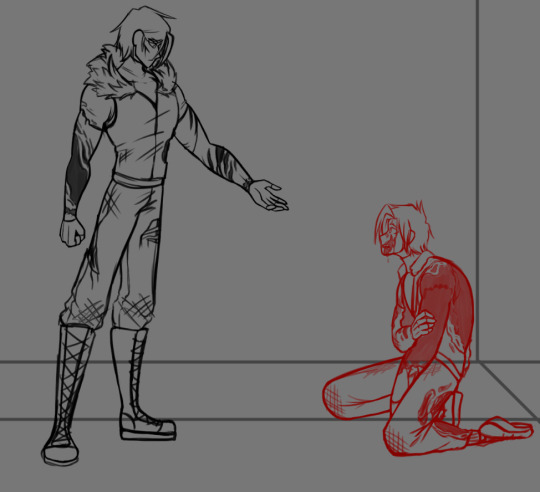


Sadly, during the process i messed up big time which led to me being unable to finish the piece the way i wanted to, rendering this project an eternal WIP. However, i still cherish the idea and do wish to either redraw, or complete it.
February
Doing 2 big projects one after another did end up affecting my overall drive, so i spent majority of that month just making sketches.

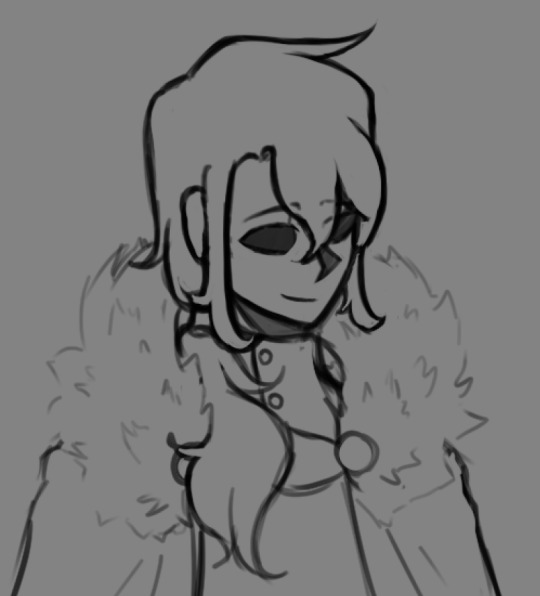
First one is a little redraw/redesign of my old character - Derek, whom i used for a roleplay with my friends like 3 or 4 years ago, and second one is Deach, a character from my fantasy setting.

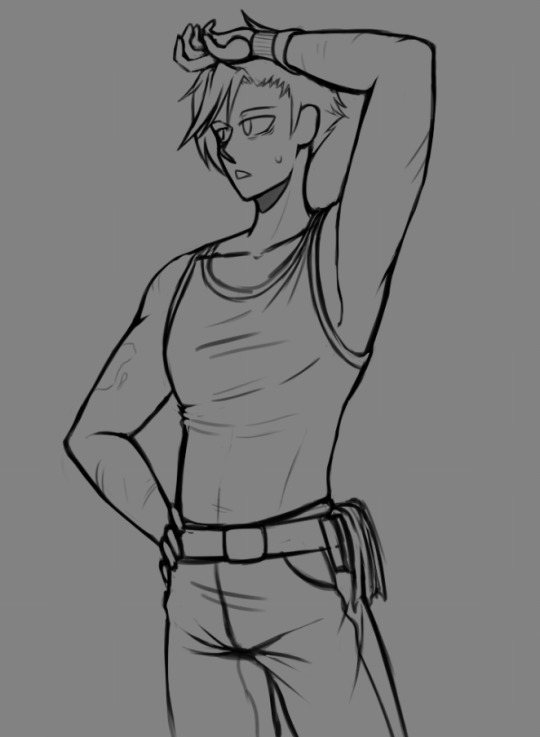
Also, back then i joined a new fandom, people in which have reminded me of my admiration for SCP, after which me and my friends proceeded to make OCs for it. Was a fun time! (Also this access card was sold by me as a YCH, sadly i couldn't really find buyers, so yikes)
March
By march is slowly started recovering from january's disappointement and was a bit more productive already. One of my friends really helped with it too.
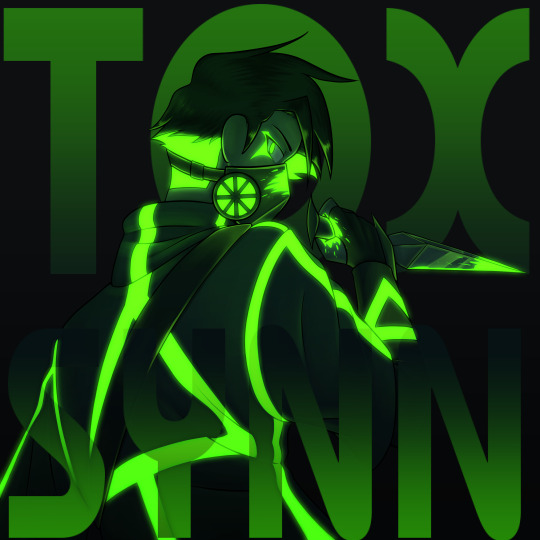
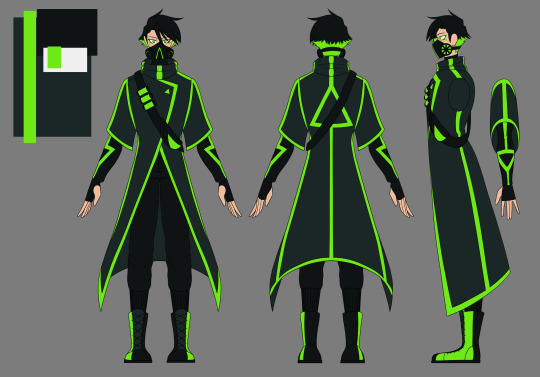
A musician friend of mine reached out to me, asking to develop a design for a villain character in the plot he was working on. After listening to the theme song i couldn't resist. This ended up being one of my favorite designs so far, and i adore its look in neon.


In the meantime, i kept working on my fantasy setting, refining more minor details of designs and stories, yet having to reserve only to making sketches as i was too busy with college and other projects. Characters you see on screen are Ian and Lanfor respectfully. One is a strong yet troubled mage and other is a great Emperor, and even better person.
April
I'd say april was one of the most productive months of this year, mostly because i managed to snatch some time for myself and my setting, which allowed me to complete two full pieces and achieve some extreme progress with my story.

This piece is an illustration to a scene i wrote for two of the characters, Lanfor and Emile, called "Night Visitor". This was a scene of a reunion of two old friends. A bittersweet, yet a lovely work. Love both the written one as well as the illustration.
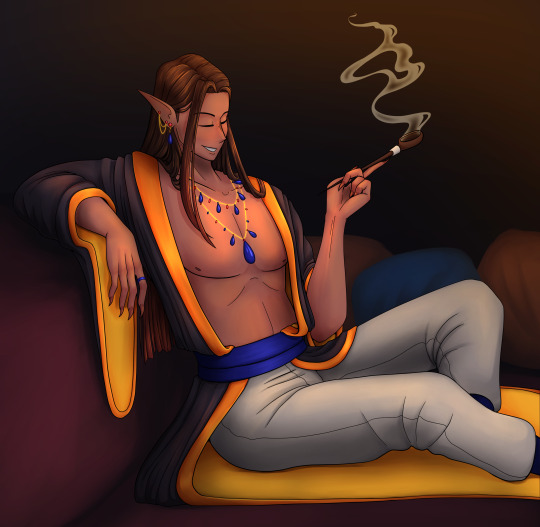
This one was more of a... Proof of concept. Needed to test out the expresiveness of the design for one or a relatively new characters - Covlar. Was originally a simple sketch on paper, but i couldn't resist the urge of making it into a complete illustration. I then proceeded to make a few notes for this scene. Both want to write it properly and avoid it at all cost... Best to avoid it, for my own sanity.
May
May was a bit of trainwreck, because i got a brand new laptop, which took me quite some time to get used to and even more time to reassure myself that it is in fact alright for me to draw on this suspicioiusly thin piece of tech.

Ironically enough, the only vomplete piece i drew that month was drawn on my old laptop. This screenshot redraw was to made to honour the premiere of AvA6 ep.1. Sadly, i did it a bit late because fo technical issues, but i still had a ton of fun doing it.
June
June was... Chaotic, to say the least. Mostly because i finally got comfortable with the new laptop and could now draw a lot more freely due to it being a lot more compact than the original one, which worked almost like a PC. Besides, i got a ton more free time because semester finals ended up being a breeze.
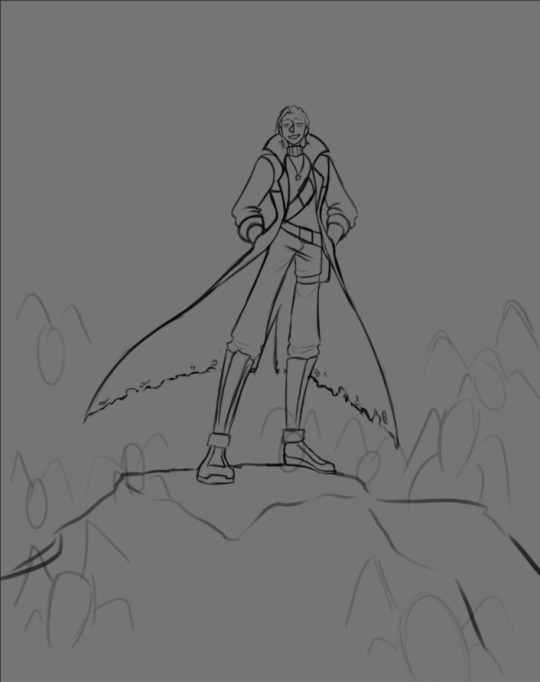

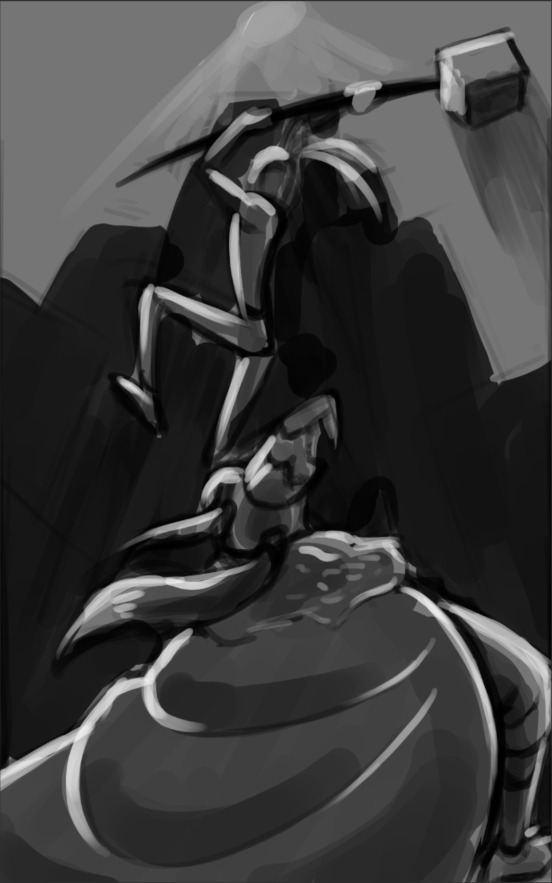
Ended up making a ton sketches and doodles, that i didn't actually plan to finish, but still enjoyed a ton. Here are some of them



Then, ofc, the memes and the gand redesign, because AvA6 just had to break all of my portrayals. But, i mean, after AvM s3 my original designs did become a bit dated.

The biggest pride and saddest of failures was this picnic piece, however. I still plan on finishing it, but it is hard doing so, when i have changed quite a bit of my artstyle by now.
July
July was quite lazy. Semester ended and i spent that entire month out of the city. It was a great time, very peaceul indeed.
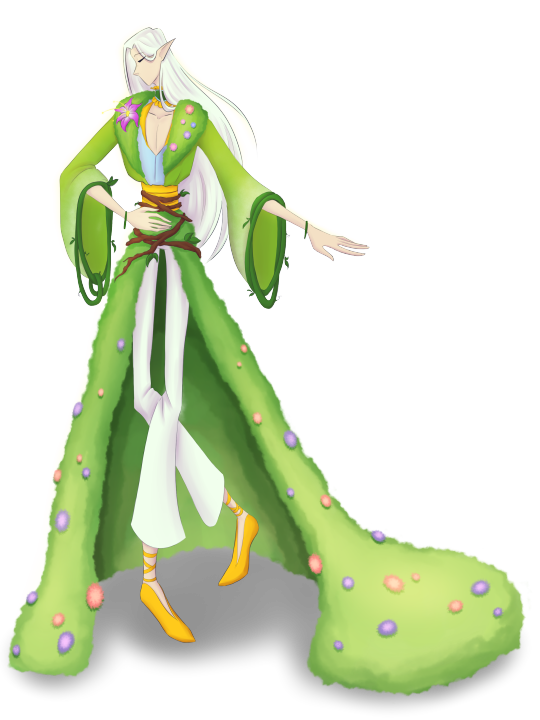
And again, that musician friend from before came into clutch, asking me to develop another design for his other project. And again a villain. He said he really liked how i draw bastard type of characters.
August
Well this is where fun began. End of summer break means i have just this much time to actually draw something i would never have time to draw normally.
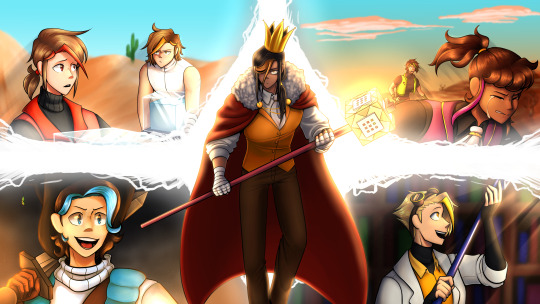
For me to draw something to commemorate a new episode is almost like a tradition at this point. And, given how long it's been since i made anything that would require effort, no wonder i have chosen arguably the most complex piece to pull off energy-wise. Yet i did and now i simply adore this piece, even if it did render me disabled. (I crunched through all of this piece, pulling off 40+ hours of work in just 4 days, so naturaly it ended up worsening my condition by a lot)
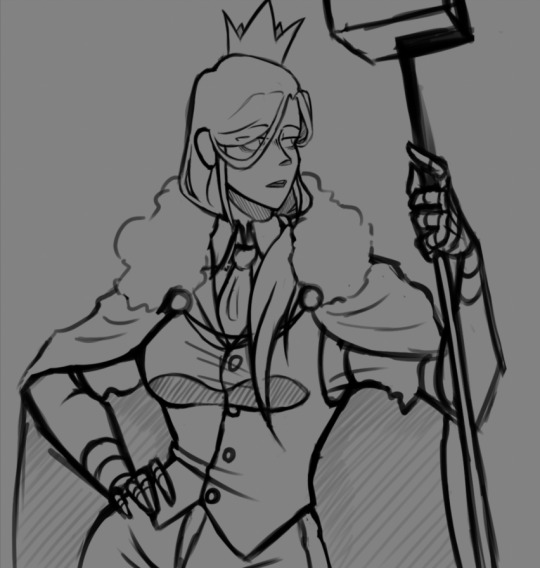


Then i also proceeded to do all of these tiny side projects, like Victim ask, which i couldn't last long at due to my condition, and working on a design for my favourite streamer. (Which i cannot show as the work is not complete an it's best if i avoid spoilers)
September and October
These two months i spent being unable to draw at all via a doctor's advice. Arguably, these two were the hardest months for me to handle.
I assume you can imagine how hard it is to suddenly stop being able to do what you love, regardless of how much you wish to do it.
Novemer
*Nervous laughter* I... actually still wasn't allowed to use my hand, but that didn't stop me and i ended up making an entire series of sketches to celebrate AvA6 ep2.
"Small in big quantity will sure be less exhausting than a single big thing" - (C) Me, proably



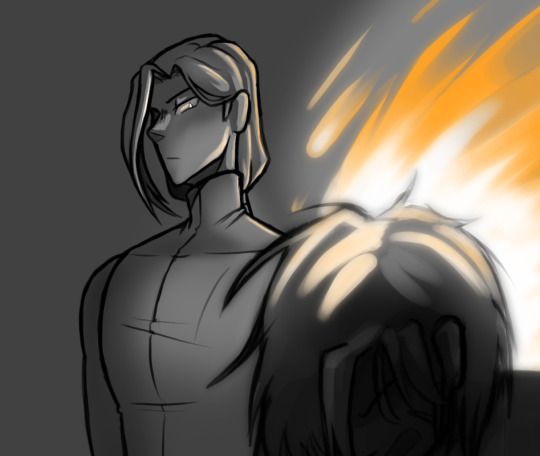
I will admit, i still adore all of these sketches and each of them deserves to become a fully fledged piece in it's own right, but i really better keep them as they are. For my own safety.
December
As you way have expected, this month will stay without a single thing from me. It's not because i don't want to, but because i can't. And, given the circumstance, it better stay that way.
Afterword
I finally got my diagnosis and soon enough i will start active treatment for my condition. It would be a shame to make this worse than it already is with impulses like those that happened in november, so i am making this post as a way to draw a line for myself.
It is still kinda crazy to realize that there are quite a few people interested in what i make, so i will make sure to take my recovery as responcible as possible, and then come back to you with even more art in the upcoming year! Let's be positive about it.
#alan becker#animation vs animator#ava#illustration#ava fanart#animation vs minecraft#avm#artists on tumblr#2023 art#yearly art summary#oc art#original character#digital art#No character tags because there are too many of them#dat's art
29 notes
·
View notes
Text
Sen's Rambles
Recently got a cute purple bow I started wearing. I got my ears pierced on Outer Science Day (8/31), coincidentally! I got some small cheap stainless steel star ones for now. After that, I'll go get some post earrings 🙏
The school semester started for me on the 4th, so I'll be busier and won't have the time to draw as often.
I'll try to keep up my posts of posting something everyday (or almost everyday) since I usually post stories right before I go to bed, art and/or rambles
I clipped my bow to my hair loosely so it doesn't tug on my hair but it almost fell off, so I'll also think about getting a bow with a scrunchy eventually too. Since I wanna wear a cute purple bow like Selena, but I still want it to be comfy. Right now this bow is still fine ^^
Cute purple Selena-esque bow 🎀💜 I got it cuz it reminded me of my wife


Admittedly I'm still thinking of what ship I wanna draw for my birthday on 9/12… I think it'll be posted late since I was mainly working on school work this week. I think it needs to be a Sen-core ship.
I was having a hard time deciding what ship I wanted to draw. I feel like it should be XanLena since Selena is my KHR OC (and beloved wife), but I'm also open to others too. I think I want to draw them in traditional Viet clothes as a redraw of my old XanLena pieces in the past.
I also considered drawing KuroEne or JuAli.
Since for JuAli, I've been sketching ideas irt a potential Tegaki fan-animatic with them. Particularly the Vocaloid Song crossover I thought of...
I also had some other ideas too of art ideas to draw with them! I wanna draw them in Chinese and Arabic traditional clothes, and then have them wear matching couple hanfu at some point.


I really want to make coloured doodle ship pieces for the rest of my ships that can match the quality of the KuroEne one I drew.
The expressions and colours are so good in my recent KuroEne art that I want to be able to match the same level of quality for my other ships too.
I've drawn KuroEne recently, so I wanna draw a ship piece with others. Though it'd be fun~ 9/6 Day is HaruTaka, KonoEne, and KuroEne Day, since 9 is Haruka/Konoha's Mekakushi Dan member code, and 6 is Takane/Ene's 🖤💛💙
Kuroha/Saeru is usually denoted as "XX" in merch since he's not apart of the Mekakushi Dan, but gets included as part of 9/6 by association.
Mr. XX
9/6 is 6 days away from my birthday, which is also Ene's MekaDan code. We were made for each other, wifey~ 💙 🤭 💘💞
Animatic Ideas
JuAli x Unfriendly Hater by Meddmia (illustrated by WOOMA)
youtube
JuAli x Wi-Fi Imagination Wild Boy by rerulili
youtube
KuroEne x Strawberry by Kashii Moimi (illustrated by SOMAZ)
youtube
KuroEne x Bougainvillea by Kashii Moimi (illustrated by Somaz)
youtube
Not a whole MV though obviously (at least not now), but an illust of them biting into a strawberry based on the Strawberry MV's illust.
Though I do eventually want to make tegaki fan-MV animatics for all of my ships. Just to name a couple. I have tons more ideas
Sen's Animatic Ideas
JuAli x Unfriendly Hater by Meddmia
JuAli x Wi-Fi Imagination Wild Boy by rerulili
KuroEne x Strawberry by Kashii Moimi
KuroEne x Bougainvillea by Kashii Moimi
Commissioning Arts
I've commissioned arts of XanLena and KuroEne from amazing artists, which I will post on main eventually ^^
I wanna commission JuAli and IdaTatsu too in the future, I'm just waiting on JuAli and IdaTatsu for now cuz I haven't finished drawing my character concept art ref sheets for them yet.
Because I want it to be art of them with my HC designs. I still need to refine my sketches and design Alibaba's outfit.
I'd love to commission LimGuda but Douman has a really detailed and complex complicated design so I think that'll be for the future.
2 notes
·
View notes
Note
4 10 20 35 !
OKAY I know you asked this a bit ago sorry i got busy!!! work!!! turtle took a tiny chunk out of my finger!! the usual! y'know What's a headcanon you need to work out? i am blanking real hard with this but i Guess what i consider to be estonia's true name b/c von bock is von bullshit has been a constant Thought of mine for a long time. sme goes for a lot of nations that have bad canon names or no canon names like what the FUCK would i name them. it takes so much effort for me to decide. How long have you been in the fandom? What's your lore? i've been around a while! i can't date exactly when i started but it was at least sometime in 2008. i Think it was in the late fall of 2007, i've been trying to do the backwards math and i think this makes sense timeline wise, but my memory isn't exactly great. i figured out yesterday i am Pretty sure i was into hetalia before den/nor/ice were released?? which is. wild to me. anyway the story is that i occasionally saw hetalia fanart in passing and i was like. what the fuck is this but i don't care enough to investigate. and then i watched darker than black and was like wow i gotta tell my (now ex-)friend about this new cool anime darker then black b/c i am enjoying it a lot and i think she would too! and then my friend was like "i am going to totally ignore you. watch this thing called hetalia instead. you like other countries and history and languages and shit you should like this it's so funny" and i watched it and i didn't find it as funny as she claimed but i thought the concept itself was utterly Fascinating and i became Obsessed. my initial favs were japan/prussia/estonia initially, all for radically different reasons. i can elaborate on that if prompted it's just more text than i care to put here. then the den/nor/ice dropped and we had some comics with the nordic 5 and i was like oH FUCK these character dynamics between them are So Fun!!! and i have been in Hell every since. this is my third time getting back into hetalia after swearing it off for good and uhhh i think i have just been in denial this entire time that i am stuck here forever. Favorite Hetalia relationship dynamic? Any combination of the Anko Trio without question. they're such an interesting little complicated group. Post a Hetalia sketch or draft you want an excuse to share i am not very good at drawing and draw from the perspective of a more refined 8 year old child or something (positive). but i also don't have anything currently drafted writing wise that feels complete enough either so i am gonna share a dumb doodle i did and also share some upcoming things i plan on doing.

one of the chapters of the SOS sequel is going to be called "The Joy Machine" and i am. very excited about that.
also have a neat NorAus idea i am obsessed with and will probably write soon-ish. once i sleep and think a bunch
5 notes
·
View notes
Text
Cheeky wee Art Recap
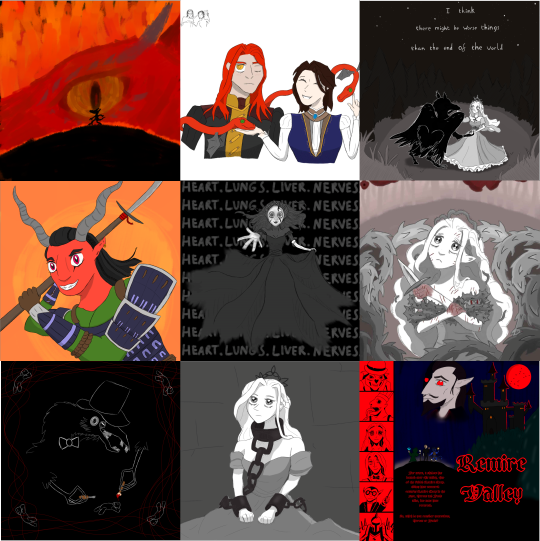
Aha haven't gotten to do anything like this before.. hmhmm.
I finally started doing digital art in October this year, and while it has presented so many skill-checks and struggle points, it's all been learning, practising, and honing whatever the hell I'm doing, which is a fun feeling.
So, I've put together the 9 things that I've been happiest with, most proud of, or just had a ton of fun making. Which I shall go into typical excruciating detail on. (and also share some traditionally done highlights for funsies)
Though in no super particular order, just visual appeal, I did purposefully place the top left, centre, and bottom right.
Top left is the initial painterly style that I first tried doing digital with, which I feel like was a style that (though I soon found the flaws with) helped my confidence in actually putting stuff down digitally, and feeling it out mechanically. I still really like how it turned out, it was a super cool visual I really wanted to portray.
Then in the middle is where Hyperfixation(TM) does its magic and unlocks your full potential. I don't really know why I was determined to draw The Nightmare digitally, but hey I was shocked by my own ability and that really gave me the drive to continue. While it has been surpassed as what I think is my best work, it fills a pretty special role in this little art journey, hence a (memed) version of it has been my pfp since I posted it.

And finally I decided to put Remire Valley bottom right since it is the most recent thing I've done (literally yesterday) and I still really like it! The opinion-decay has been weaker than usual which is nice.
I still believe that Thorn (middle right) is the best thing I've made so far, and in general I'm like, so thankful to the slay the princess creators for inspiring me and influencing my art style in a way that I love.
My New Years resolution is to continue to draw pretty and/or spooky girls. and maybe a guy, sometimes.
Bonus Traditional Highlights
I did also some random traditional drawings here and there, mosty from before I started doing digital, though I believe the earliest drawing I'm gonna show here comes from about August.

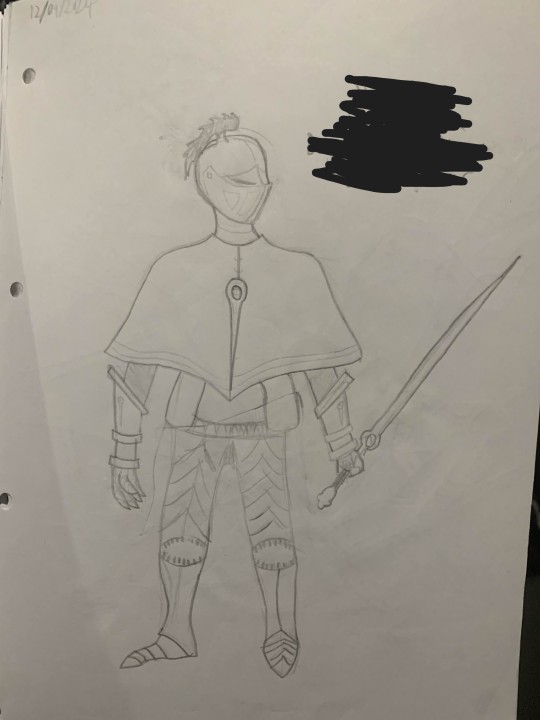
Never showed it off but I did this little practice of closed helmets which I found pretty fun, looked at some cool helmet references and tried my best to work out the shapes, and I think they actually turned out pretty cool. This study was done to prepare for doing the character design on the right, who is a prepared NPC for the dnd campaign, though I expect it will be some time until they ever turn up, so barring blocking their name/title I feel okay with showing them here in terms of spoilers. I can confidently say that they are not associated with any current plot threads, so they will arise when their own little story comes up.
Speaking of the dnd campaign, that was probably my biggest motivator for traditional art, I did so many sketches/concept art for things I have put in the campaign (and lots of things that are yet to appear, as seen). Of these, by far the ones I'm happiest with are the Peccatorum soldiers and their leader, The Pontiff.
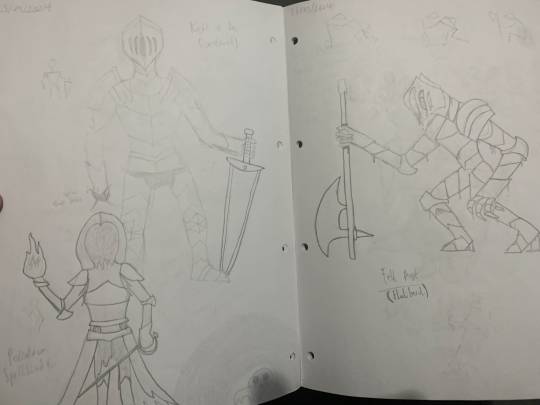

There's one other traditional thing that I thought I'd share, since it was a pretty neat exercise in character concepts and design, those being some interpretations of the 4 horsemen of the apocalypse.
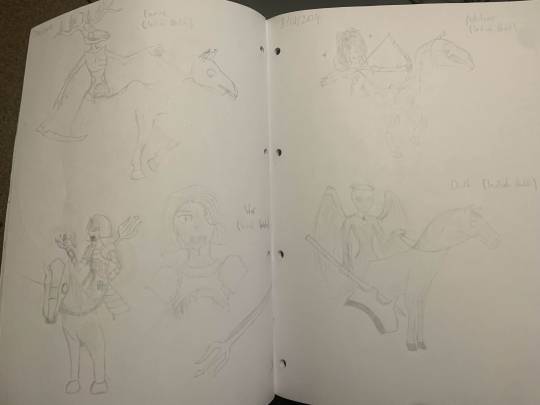
(or horsewomen, because of course they are)
These designs are probably my current idea for a redo in digital, since I really like some of the concepts and design elements, whilst I'd probably change/refine some others. That'll probably be my next big project, but I have ideas for other smaller drawings, and every now and then I'm still opening up the sketchbook to just do whatever.
So yeah, if there's one thing I can say about 2024 it's that it brought about the actualisation of multiple creative outlets (the dnd campaign, and doing more art than ever) which I'm super happy about, and I look forward to doing even more and seeing what 2025 will look like.
1 note
·
View note
Text
WEEK 2:
Before the start of the week, my group organised a voice call to present our different ideas for each prompt. In this call we presented Pinterest Boards, concept art and character designs we had made outside of class time. We decided to proceed with the Apocalypse concept we had started last week but we took ideas from the other concepts and including them moving forward. For instance, in Mia's concept, Modern Day Greek Myth, she focused alot on religious themes, so we thought to include them in our apocalypse concept moving forward.

I initially made a character design for our protagonist, which Dean then made his own design based off, I then further refined our character design by combining elements from the two designs. I think we need to then simplify this design to make it easier to animate, which Sarah has done in a few sketches. (as seen below)

Sarah also made an amazing monster design for our antagonist, we collaborated on this design over call but Sarah’s monster design skills are incredible! We wanted our monster to be some sort of insect with human-like features. Taking inspiration from body horror, Cronenburg and game series like Silent Hill and Dark Souls, and also real life! Many insects are known to have patterns which resemble eyes to ward off predators, we wanted to imitate these design elements in our antagonists design.


Perspective exercises
We were instructed to create a one point and two point perspective grid and draw 3D cubes, following the guidelines of that grid. I was suing Procreate, which as a built in perspective grid feature, so it felt a bit like cheating, but I suppose if you have the tools use them. I wish I spent more time on these as they are slightly wonky, but they’re just exercises and practice is practice. I actually really like drawing characters in perspective, which makes me sound like a sicko, but I think it’s fun drawing the human body from different angles! I’m excited for doing it in future classes.


Thumbnails
For homework we were instructed to make 6 thumbnails of possible shots in our world. So I developed the composition thumbnails we did earlier to be more detailed. I wanted to try and incorporate as many story elements our group developed as possible; the nuclear incident, the religious themes, the location and the antagonist. I used references from the slide show our group developed together, particularly the world ideas slides ->


I used grey scale just to keep it simple and to easily differentiate shapes and space. I found this exercise very fun! This is the stuff I love in animation - making visually interesting shots, and telling a story via those images.

I wanted to make this world feel dark, cold, damp and lonely. I didn’t draw any people besides our main character, and when I did draw him, I often didn’t show his face, and when I did it’s often obscured or in shadow. While moving forward with this project, I want to maintain this feeling of the world.
0 notes
Note
👀 may we know more about rhythm man?
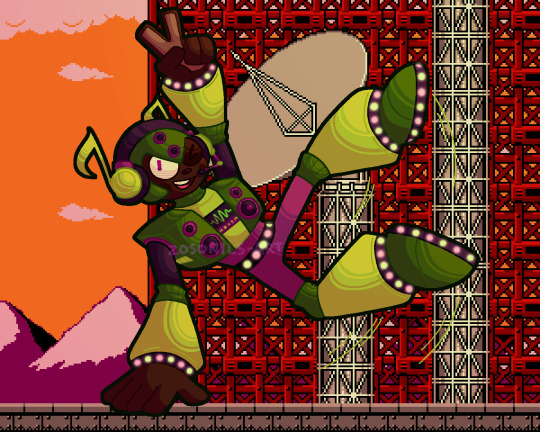
we sure may!!!!! rhythm dump under the cut as always
rhythm man was made to do a variety of tasks relating to sound! mostly he either does sound checks for important devices like hydrophones, sonar, seti listening devices, stuff like that, or he analyses the audio that they pick up in greater detail than any human or almost any computer can. someone [probably dr light, who created him] showed him a rhythm game pretty early in his life, and he instantly fell in love with the game genre and, more significantly, the concept of music itself. he's still doing the job he was designed for, but his real passion and arguably what he's better known for in-universe is creating music, which he uses his intricate understanding of audio to excel at
he makes a point of being a cool guy to be around! he's nice, fun-loving, and always has a joke ready. he's very encouraging of others, and thinks everyone should get to chase their dreams and do what makes them happy. when there's no bright side for him to look on, though, he doesn't really know how to act, and as such he feels uncomfortable confronting serious emotional situations and has a bad habit of repressing any negative feelings he doesn't know how to deal with and just letting them get worse. he might be developing some resentment towards his work for how much of his time it takes up that he'd rather be spending pursuing his interests, but oops that's not a fun feeling! better bottle it up and not think about it
all robots are neurodivergent but rhythm in particular has SO much undiagnosed adhd. he [probably] doesn't mind his job, but he can't pretend to be nearly as enthusiastic about it as he is his music, and tends to come off as distracted and spacey when he's at work. he's also capable of entering a hyperfocus-like state that temporarily re-allocates computing power usually dedicated to spatial awareness and sensory processing to focus on something else, which was designed to let him analyse audio with even more precision. rhythm occasionally uses this feature as intended, but more often finds himself turning it on while he's making music or playing a game to get into the groove more
he'll gladly enjoy any genre of music, but anything under the electronic umbrella is his favourite to listen to and create, especially bass music and all its subgenres! outside of genre preferences he likes songs with a lot of tiny bits and pieces and intricate details to notice - i think he'd really enjoy bill wurtz's music, for instance, due to just how much is going on in almost every song. he posts the music he makes online, and has a pretty sizeable following for both the novelty of a robot that makes music and the fact that everything he makes genuinely slaps super hard. being a robot, his criteria for 'good' music is all very simple and objective stuff like whether it's in key or has a time signature that makes sense or follows a pattern rather than just being random sounds, so he's able to appreciate almost any music for what it is and can name the number of songs he actively dislikes on one hand, although despite his best efforts to be forgiving he's a bit of an audio quality snob
the only sound he genuinely doesn't like is white noise, because the total lack of a discernable pattern or anything notable freaks him out. it's hard-coded into him to try and find meaningful noise in very fuzzy sound, and even if he analyses it back and forth on every level and concludes that it's just random aural static he's still left with a feeling of unease about it. his headphones have a sort of noise-cancelling mode that completely blocks out most background noise so he can maintain a conversation without constantly pausing to overanalyse everything he hears - without the noise cancelling he's got the world's worst case of auditory processing disorder. he's weak to psychic cry because it's just a really violent blast of white noise, and is one of the only bosses susceptible to its stunning effect because the sound freaks him out so badly he has to stop for a moment to force himself to ignore it
almost everything about rhythm came from the idea i had for his stage! i imagine it functioning as a sort of rhythm platformer where almost every moving part is timed to the beat of the stage music. it's the obligatory yoku block-spamming stage of the game, but in theory if you follow the music and jump across in time with the beat you'll make it through without much trouble [and maybe even have fun! in a stage with *yoku blocks!!*]. other stuff like constantly-spawning enemies and the attack patterns of rhythm himself would also be on that same beat cycle! as for theming, his stage is a mostly-vertical climb up a radio tower - wily's reprogramming takes his repressed frustration over not always getting to focus on his passion and upgrades it to outright spite, and he decides that actually you WILL listen to his mixtape whether you want to or not and proceeds to hijack the biggest radio tower in mosteropolis and override every single station with lofi beats to take over the world to
rhythm is the first robot master idea i ever had that wasn't a reference to something else, although for a pretty long time he was only a stage idea and a name. maybe that's why his design changed more throughout his development than any of the other guys [even between the sketch and the final lineart for this art i refined his look like 3 times]. initially he had a more 'tough'/punk-ish look, with spikes on his helmet and around his wrists and ankles, but i ended up phasing most of those elements out in favour of the led lights and generally less intimidating look. i briefly considered having his design reference rhythm heaven somehow, since it's my favourite rhythm game and the only one i'm any good at lmao, but nothing came of that - perhaps his stage enemies could have some rh references in their ranks instead, chuck some screwbots up there or something. he also had massive anime sunglasses at some point but it's better for that design to never see the light of day
he also likes dancing! hence his funky moves in the art. his body shape isn't compatible with every dance style what with the clunky robot limbs and having a stereo for a chest, and he definitely wasn't built for physical agility, but with a little practice he can pick up most dance moves no problem. he's definitely a dance battler, and i think he would love rhythm games that trick you into exercising like dance dance revolution or just dance. rhythm man does a frame perfect ddr tas in real-time on an actual cabinet
that about wraps it up for the rhythm infodump, thank you for asking about him!! as always here's the unfiltered and transparent versions of his artwork


#i'm really proud of myself for coming up with the quaver headphones. i think those look neat#zos draws#mega man#mega man oc#robot master oc#rhythm man#zos answers#zos talks#anon#zoriginal characters
30 notes
·
View notes
Text
Wing Series Process
Everyone is so nice, first of all, it’s been such a rewarding thing to work on because the tags you all leave are just the best. And I’m someone who takes a lot of screenshots as I’m working on things to show to people (mutuals lmk if you want that!) so under the cut we have some first sketches, process pictures, and even more frames/wing sketches (mostly HwanWoong) that I don’t plan on refining any further.

I regret to inform everyone that after a while I got tired and stopped naming layers, but here’s a peek at some of the ones for Hwanwoong’s:

LMFAO
I don’t know if it’s truly around 100 layers or not, it may have pulled that from the frame number. I started by looking for frames I thought would work well and then sketching out the wing pose that came to mind in some color that would stand out. Here’s Xion’s first sketch:

Unreferenced, just putting in the shapes I thought would look good. His final wings ended up being based off of various falcons, but I don’t claim to be an ornithologist so nobody @ me.
The first three in the series used no references whatsoever, they’re very much whimsical fantasy wings only.
I really struggled to find something for Hwanwoong that had him framed in the shot a way I particularly liked, so here’s some attempts and some spitefully drawing on music videos I wasn’t sourcing from for this set:





Testing the wings matching the hair concept, which unfortunately looked rad as shit so I put off working on it for a few days because I k n e w it would be a thousand layers and a lot of work.

Finally decided I was okay painting some of the others out and sketched out the pose.

I mostly used barn owls as reference to get those good rounded shapes but I don’t pretend the ending product is anything but unicorn wings and only those




Colored lineart to help establish some base colors for when I filled in the wings more, sourced from other pictures of the rainbow hair with much better lighting than this one, and I did also paint on his hair some to bring everything together, if you look at the finished piece closer you can probably tell


I ended up repainting the smaller feathers on the leftside wing entirely since I didn’t love how it was coming out and wanted more of a color spread.


had the canvas extended up until the very end! I think you can tell if lines were drawn from fully behind something or not so I needed the space to paint in the fluffier feathers sticking up on each other.

just cleaning up the edges to go! You can see the sort of sparkle effect from some speckle brushes on the right side at this point.

cleaner edges and final color adjustments and it’s finished!
thanks for reading, I hope it was fun to see more of how the colors filled in and thanks for enjoying these so much!

#this might be an art blog#*#*process#seriously there's 7 free ones in here#they're unpainted but more wingggggss#oneus
14 notes
·
View notes
Note
So... Morrison’s 10 part interview on All-Star Superman, along with all other older Newsarama articles, just seem to have ceased to exist. One does not simply live without having those interviews available to reread... Can I find them anywhere else?
Rejoice! I finally borrowed a computer I could put my flash drive into, and emailed myself my copy of the Morrison interview. Here it is below the cut, copied and pasted direct from the source way back when, available again at last:
Three years, 12 issues, Eisners and countless accolades later, All Star Superman is finally finished. The out-of-continuity look at Superman’s struggle with his inevitable death was widely embraced by fans and pros as one of the best stories to feature the Man of Steel, and was a showcase for the talents of the creative team of Grant Morrison, Frank Quitely and Jamie Grant.
Now, Newsarama is proud to present an exclusive look back with Morrison at the series that took Superman to, pun intended, new heights. We had a lot of questions about the series...and Morrison delivered with an in-depth look into the themes, characters and ideas throughout the 12 issues. In fact, there was so much that we’re running this as an unprecedented 10-part series over the next two weeks – sort of an unofficial All Star Superman companion. It’s everything about All Star Superman you ever wanted to know, but were afraid to ask.
And of course there’s plenty of SPOILERS, so back away if you haven’t read the entire series.
Newsarama: Grant, tell us a little about the origin of the project.
Grant Morrison: Some of it has its roots in the DC One Million project from 1999. So much so, that some readers have come to consider this a prequel to DC One Million, which is fine if it shifts a few more copies! I’ve tried to give my own DC books an overarching continuity intended to make them all read as a more coherent body of work when I’m done.
Luthor’s “enlightenment” – when he peaks on super–senses and sees the world as it appears through Superman’s eyes – was an element I’d included in the Superman Now pitch I prepared along with Mark Millar, Tom Peyer and Mark Waid back in 1999. There were one or two of ideas of mine that I wanted to preserve from Superman Now and Luthor’s heart–stopping moment of understanding was a favorite part of the original ending for that story, so I decided to use it again here.
My specific take on Superman’s physicality was inspired by the “shamanic” meeting my JLA editor Dan Raspler and I had in the wee hours of the morning outside the San Diego comic book convention in whenever it was, ‘98 or ‘99.
I’ve told this story in more detail elsewhere but basically, we were trying to figure out how to “reboot” Superman without splitting up his marriage to Lois, which seemed like a cop–out. It was the beginning of the conversations which ultimately led to Superman Now, with Dan and I restlessly pacing around trying to figure out a new way into the character of Superman and coming up short...
Until we looked up to see a guy dressed as Superman crossing the train tracks. Not just any skinny convention guy in an ill–fitting suit, this guy actually looked like Superman. It was too good a moment to let pass, so I ran over to him, told him what we’d been trying to do and asked if he wouldn’t mind indulging us by answering some questions about Superman, which he did...in the persona and voice of Superman!
We talked for an hour and a half and he walked off into the night with his friend (no, it wasn’t Jimmy Olsen, sadly). I sat up the rest of the night, scribbling page after page of Superman notes as the sun came up over the naval yards.
My entire approach to Superman had come from the way that guy had been sitting; so easy, so confident, as if, invulnerable to all physical harm, he could relax completely and be spontaneous and warm. That pose, sitting hunched on the bollard, with one knee up, the cape just hanging there, talking to us seemed to me to be the opposite of the clenched, muscle-bound look the character sometimes sports and that was the key to Superman for me.
I met the same Superman a couple of times afterwards but he wasn’t Superman, just a nice guy dressed as Superman, whose name I didn’t save but who has entered into my own personal mythology (a picture has from that time has survived showing me and Mark Waid posing alongside this guy and a couple of young readers dressed as Superboy and Supergirl – it’s in the “Gallery” section at my website for anybody who can be bothered looking. This is the guy who lit the fuse that led to All Star Superman).
After the 1999 pitch was rejected, I didn’t expect to be doing any further work on Superman but sometime in 2002, while I was going into my last year on New X–Men, Dan DiDio called and asked if I wanted to come back to DC to work on a Superman book with Jim Lee.
Jim was flexing his artistic muscles again to great effect, and he wanted to do 12 issues on Superman to complement the work he was doing with Jeph Loeb on “Batman: Hush.” At the time, I wasn’t able to make my own commitments dovetail with Jim’s availability, but by then I’d become obsessed with the idea of doing a big Superman story and I’d already started working out the details.
Jim, of course, went on to do his 12 Superman issues as “For Tomorrow” with Brian Azzarello, so I found myself looking for an artist for what was rapidly turning into my own Man of Steel magnum opus, and I already knew the book had to be drawn by my friend and collaborator, Frank Quitely.
We were already talking about We3 and Superman seemed like a good meaty project to get our teeth into when that was done. I completely scaled up my expectations of what might be possible once Frank was on board and decided to make this thing as ambitious as possible.
Usually, I prefer to write poppy, throwaway “live performance” type superhero books, but this time, I felt compelled to make something for the ages – a big definitive statement about superheroes and life and all that, not only drawn by my favorite artist but starring the first and greatest superhero of them all.
The fact that it could be a non–continuity recreation made the idea even more attractive and more achievable. I also felt ready for it, in a way I don’t think I would have been in 1999; I finally felt “grown–up” enough to do Superman justice.
I plotted the whole story in 2002 and drew tiny colored sketches for all 12 covers. The entire book was very tightly constructed before we started – except that I’d left the ending open for the inevitable better and more focused ideas I knew would arise as the project grew into its own shape...and I left an empty space for issue 10. That one was intended from the start to be the single issue of the 12–issue run that would condense and amplify the themes of all the others. #10 was set aside to be the one–off story that would sum up anything anyone needed to know about Superman in 22 pages.
Not quite as concise an origin as Superman’s, but that’s how we got started.
NRAMA: When you were devising the series, what challenges did you have in building up this version of the Superman universe?
GM: I couldn’t say there were any particular challenges. It was fun. Nobody was telling me what I could or couldn’t do with the characters. I didn’t have to worry about upsetting continuity or annoying people who care about stuff like that.
I don’t have a lot of old comics, so my knowledge of Superman was based on memory, some tattered “70s books from the remains of my teenage collection, a bunch of DC “Best Of...” reprint editions and two brilliant little handbooks – “Superman in Action Comics” Volumes 1 and 2 – which reprint every single Action Comics cover from 1938 to 1988.
I read various accounts of Superman’s creation and development as a brand. I read every Superman story and watched every Superman movie I could lay my hands on, from the Golden Age to the present day. From the Socialist scrapper Superman of the Depression years, through the Super–Cop of the 40s, the mythic Hyper–Dad of the 50s and 60s, the questioning, liberal Superman of the early 70s, the bland “superhero” of the late 70s, the confident yuppie of the 80s, the over–compensating Chippendale Superman of the 90s etc. I read takes on Superman by Mark Waid, Mark Millar, Geoff Johns, Denny O’Neil, Jeph Loeb, Alan Moore, Paul Dini and Alex Ross, Joe Casey, Steve Seagle, Garth Ennis, Jim Steranko and many others.
I looked at the Fleischer cartoons, the Chris Reeve movies and the animated series, and read Alvin Schwartz’s (he wrote the first ever Bizarro story among many others) fascinating book – “An Unlikely Prophet” – where he talks about his notion of Superman as a tulpa, (a Tibetan word for a living thought form which has an independent existence beyond its creator) and claims he actually met the Man of Steel in the back of a taxi.
I immersed myself in Superman and I tried to find in all of these very diverse approaches the essential “Superman–ness” that powered the engine. I then extracted, purified and refined that essence and drained it into All Star’s tank, recreating characters as my own dream versions, without the baggage of strict continuity.
In the end, I saw Superman not as a superhero or even a science fiction character, but as a story of Everyman. We’re all Superman in our own adventures. We have our own Fortresses of Solitude we retreat to, with our own special collections of valued stuff, our own super–pets, our own “Bottle Cities” that we feel guilty for neglecting. We have our own peers and rivals and bizarre emotional or moral tangles to deal with.
I felt I’d really grasped the concept when I saw him as Everyman, or rather as the dreamself of Everyman. That “S” is the radiant emblem of divinity we reveal when we rip off our stuffy shirts, our social masks, our neuroses, our constructed selves, and become who we truly are.
Batman is obviously much cooler, but that’s because he’s a very energetic and adolescent fantasy character: a handsome billionaire playboy in black leather with a butler at this beck and call, better cars and gadgetry than James Bond, a horde of fetish femme fatales baying around his heels and no boss. That guy’s Superman day and night.
Superman grew up baling hay on a farm. He goes to work, for a boss, in an office. He pines after a hard–working gal. Only when he tears off his shirt does that heroic, ideal inner self come to life. That’s actually a much more adult fantasy than the one Batman’s peddling but it also makes Superman a little harder to sell. He’s much more of a working class superhero, which is why we ended the whole book with the image of a laboring Superman.
He’s Everyman operating on a sci–fi Paul Bunyan scale. His worries and emotional problems are the same as ours... except that when he falls out with his girlfriend, the world trembles.
Newsarama: Grant, what are some of your favorite moments from the 12 issues?
Grant Morrison: The first shot of Superman flying over the sun. The Cosmic Anvil. Samson and Atlas. The kiss on the moon. The first three pages of the Olsen story which, I think, add up to the best character intro I’ve ever written.
Everything Lex Luthor says in issue #5. Everything Clark does. The whole says/does Luthor/Superman dynamic as played out through Frank Quitely’s absolute mastery and understanding of how space, movement and expression combine to tell a story.
Superboy and his dog on the moon – that perfect teenage moment of infinite possibility, introspection and hope for the future. He’s every young man on the verge of adulthood, Krypto is every dog with his boy (it seemed a shame to us that Krypto’s most memorable moment prior to this was his death scene in “Whatever Happened To The Man of Tomorrow.” Quitely’s scampering, leaping, eager and alive little creature is how I’d prefer to imagine Krypto the Superdog and conjures finer and more subtle emotions).
Bizarro–Home, with all of Earth’s continental and ocean shapes but reversed. The page with the first appearance of Zibarro that Frank has designed so the eye is pulled down in a swirling motion into the drain at the heart of the image, to make us feel that we’re being flushed in a cloacal spiral down into a nihilistic, existential sink. Frank gave me that page as a gift, and it became weirdly emblematic of a strange, dark time in both our lives.
The story with Bar–El and Lilo has a genuine chill off ammonia and antiseptic off it, which makes it my least favorite issue of the series, although I know a lot of people who love it. It’s about dying relatives, obligations, the overlit overheated corridors between terminal wards, the thin metallic odors of chemicals, bad food and fear. Preparation for the Phantom Zone.
Superman hugging the poor, hopeless girl on the roof and telling us all we’re stronger than we think we are.
Joe Shuster drawing us all into the story forever and never–ending.
Nasthalthia Luthor. Frank and Jamie’s final tour of the Fortress, referencing every previous issue on the way, in two pages.
All of issue #10 (there’s a single typo in there where the time on the last page was screwed up – but when we fix that detail for the trade I’ll be able to regard this as the most perfectly composed superhero story I’ve ever written).
I don’t think I’ve ever had a smoother, more seamless collaborative process.
NRAMA: The story is very complete unto itself, but are there any new or classic characters you’d like to explore further? If so, which ones and why?
GM: I’d happily write more Atlas and Samson. I really like Krull, the Dino–Czar’s wayward son, and his Stalinist underground empire of “Subterranosauri.” I could write a Superman Squad comic forever. I’d love to write the “Son of Superman” sequel about Lois and Clark’s super test tube baby.
But...I think All Star is already complete, without sequels. You read that last issue and it works because you know you’re never going to see All Star Superman again. You’ll be able to pick up Superman books, but they won’t be about this guy and they won’t feel the same. He really is going away. Our Superman is actually “dying” in that sense, and that adds the whole series a deeper poignancy.
NRAMA: Aside from the Bizarro League, you never really introduce other DC superheroes into the story. Why did you make this choice?
GM: I wanted the story to be about the mythic Superman at the end of his time. It’s clear from the references that he has or more likely has had a few super–powered allies, but that they’re no longer around or relevant any more.
For the context of this story I wanted the super–friends to be peripheral, like they were in the old comics. The Flash? Green Lantern? They represent Superman’s “old army buddies,” or your dad’s school friends. Guys you’ve sort of heard of, who used to be more important in the old man’s life than they are now.
NRAMA: Some readers were confused as to how the “Twelve Labors” broke down, though others have pointed out that Superman’s actions are more reflective of the Stations of the Cross (I note there’s a “Station Café” in the background of issue #12). Could you break down the Twelve Labors, or, if the cross theory is true, how the storyline reflects the Stations?
GM: The 12 Labors of Superman were never intended as an isomorphic mapping onto the 12 Labors of Hercules, or for that matter, the specific Stations of the Cross, of which there are 14, I believe. I didn’t even want to do one Labor per issue, so it deliberately breaks down quite erratically through the series for reasons I’ll go into (later).
Yes, there are correspondences, but that’s mostly because we tried to create for our Superman the contemporary “superhero” version of an archetypal solar hero journey, which naturally echoes numerous myths, legends and religious parables.
At the same time, we didn’t want to do an update or a direct copy of any myth you’d seen before, so it won’t work if you try to find one specific mythological or religious “plan” to hang the series on; James Joyce’s honorable and heroic refutation of the rule aside, there’s nothing more dead and dull than an attempt to retell the Odyssey or the Norse sagas scene by scene, but in a modern and/or superhero setting.
For future historians and mythologizers, however, the 12 Labors of Superman may be enumerated as follows:
1. Superman saves the first manned mission to the sun.
2. Superman brews the Super–Elixir.
3. Superman answers the Unanswerable Question.
4. Superman chains the Chronovore.
5. Superman saves Earth from Bizarro–Home.
6. Superman returns from the Underverse.
7. Superman creates Life.
8. Superman liberates Kandor/cures cancer.
9. Superman defeats Solaris.
10. Superman conquers Death.
11. Superman builds an artificial Heart for the Sun.
12.Superman leaves the recipe/formula to make Superman 2.
And one final feat, which typically no–one really notices, is that Lex Luthor delivers his own version of the unified field haiku – explaining the underlying principles of the universe in fourteen syllables – which the P.R.O.J.E.C.T. G–Type philosopher from issue 4 had dedicated his entire life to composing!
You may notice also that the Labors take place over a year – with the solar hero’s descent into the darkness and cold of the Underverse occurring at midwinter/Christmas time (that’s also the only point in the story where we ever see Metropolis at night).
It can also be seen as the sun’s journey over the course of a day – we open in blazing sunshine but halfway through the book, at the end of issue #5, in fact, the solar hero dips below the horizon and begins the night–journey through the hours of darkness and death, before his triumphant resurrection at dawn. That’s why issue 5 ends with the boat to the Underworld and 6 begins with the moon. Clark Kent is crossing the threshold into the subconscious world of memory, shadows, death and deep emotions.
Although they can often have bizarre resonances, specific elements, like the Station Café, are usually put there by Frank Quitely, and are not necessarily secret Dan Brown–style keys to unlocking the mysteries. I think there might be a Station Café opposite the studio where Frank Quitely works and the “SAPIEN” sign on another storefront is a reference to Frank’s studio mate, Dave Sapien. At least he’s not filling the background with dirty words like he used to, given any opportunity
NRAMA: For that matter, do the Twelve Labors matter at all? They seem so purposely ill–defined. They seem more like misdirection or a MacGuffin than anything that needs to be clearly delineated.
GM: They matter, of course, but the 12 Labors idea is there to show that, as with all myth, the systematic ordering of current events into stories, tales, or legends occurs after the fact.
I’m trying to suggest that only in the future will these particular 12 feats, out of all the others ever, be mythologized as 12 Labors. I suppose I was trying to say something about how people impose meaning upon events in retrospect, and that’s how myth is born. It’s hindsight that provides narrative, structure, meaning and significance to the simple unfolding of events. It’s the backward glance that adds all the capital letters to the list above.
Even Superman isn”t sure how many Labors he’s performed when we see him mulling it over in issue 10.
When you watched it happening, it seemed to be Superman just doing his thing. In the future it’s become THE 12 LABORS OF SUPERMAN!
NRAMA: And on a completely ridiculous note: All–Star Superman is perhaps the most difficult–to–abbreviate comic title since Preacher: Tall in the Saddle. Did you realize this going in?
GM: Going into what? Going into ASS itself? In the sense of how did I feel as I slowly entered ASS for the first time?
It never crossed my mind...
Newsarama: I’d like to know a little more about Leo Quintum and his role in the story. He seems like a bit of an outgrowth of the likes of Project Cadmus and Emil Hamilton, but in a more fantastical, Willy Wonka sense.
Grant Morrison: Yeah, he was exactly as you say, my attempt to create an updated take on the character of “Superman’s scientist friend” – in the vein of Emil Hamilton from the animated show and the ‘90s stories. Science so often goes wrong in Superman stories, and I thought it was important to show the potential for science to go right or to be elevated by contact with Superman’s shining positive spirit.
I was thinking of Quintum as a kind of “Man Who Fell To Earth” character with a mysterious unearthly background. For a while I toyed with the notion that he was some kind of avatar of Lightray of the New Gods, but as All Star developed, that didn’t fit the tone, and he was allowed to simply be himself.
Eventually it just came down to simplicity. Leo Quintum represents the “good” scientific spirit – the rational, enlightened, progressive, utopian kind of scientist I figured Superman might inspire to greatness. It was interesting to me how so many people expected Quintum to turn out bad at the end. It shows how conditioned we are in our miserable, self–loathing, suspicious society to expect the worst of everyone, rather than hope for the best. Or maybe it’s just what we expect from stories.
Having said that, there is indeed a necessary whiff of Lucifer about Quintum. His name, Leo Quintum, conjures images of solar force, lions and lightbringers and he has elements of the classic Trickster figure about him. He even refers to himself as “The Devil Himself” in issue #10.
What he’s doing at the end of the story should, for all its gee–whiz futurity, feel slightly ambiguous, slightly fake, slightly “Hollywood.” Yes, he’s fulfilling Superman’s wishes by cloning an heir to Superman and Lois and inaugurating a Superman dynasty that will last until the end of time – but he’s also commodifying Superman, figuring out how it’s done, turning him into a brand, a franchise, a bigger–and–better “revamp,” the ultimate coming attraction, fresher than fresh, newer than new but familiar too. Quintum has figured out the “formula” for Superman and improved upon it.
And then you can go back to the start of All Star Superman issue #1 and read the “formula” for yourself, condensed into eight words on the first page and then expanded upon throughout the story! The solar journey is an endless circle naturally. A perfect puzzle that is its own solution.
In one way, Quintum could be seen to represent the creative team, simultaneously re–empowering a pure myth with the honest fire of Art...while at the same time shooting a jolt of juice through a concept that sells more “S” logo underpants and towels than it does comic books. All tastes catered!
I have to say that the Willy Wonka thing never crossed my mind until I saw people online make the comparison, which seems quite obvious now. Quintum dresses how I would dress if I was the world’s coolest super–scientist. What’s up with that?
NRAMA: Was Zibarro inspired by the Bizarro World story where the Bizarro–Neanderthal becomes this unappreciated Casanova–type?
GM: Don’t know that one, but it sounds like a scenario I could definitely endorse!
Zibarro started out as a daft name sicked–up by my subconscious mind, which flowered within moments into the must–write idea of an Imperfect Bizarro. What would an imperfect version of an already imperfect being be like?
Zibarro.
NRAMA: I’d like to know more about Zibarro – what’s the significance of his chronicling Bizarro World through poetry?
GM: It’s up to you. I see Zibarro partly as the sensitive teenager inside us all. He’s moody, horribly self–aware and uncomfortable, yet filled with thoughts of omnipotence and agency. He’s the absolute center of his tiny, disorganized universe. He’s playing the role of sensitive, empathic poet but at the same time, he’s completely self–absorbed.
When he says to Superman “Can you even imagine what it’s like to be so different. So unique. So unlike everyone else?” he doesn’t even wait for Superman’s reply. He doesn’t care about anyone’s feelings but his own, ultimately.
NRAMA: The character is very close to Superman, so what does it say that a nonpowered version on a savage world would focus his energy through that medium? Also, does Zibarro’s existence show how Superman is able to elevate even the backwards Bizarros through his very nature?
GM: All of the above. And maybe he writes his totally subjective poetry as a reflection of Clark Kent’s objective reporter role. The suppressed, lyrical, wounded side of Superman perhaps? The Super–Morrissey? Bizarro With The Thorn In His Side?
But he’s also Bizarro–Home’s “mistake” (or so it seems to him, even though he’s as natural an expression of the place as any of the other Bizarro creatures who grow like mold across the surface of their living planet). He feels excluded, a despised outsider, and yet that position is what defines his cherished self–image. He expresses himself through poetry because to him the regular Bizarro language is barbaric, barely articulate and guttural. And they all think he’s talking crap anyway.
It seemed to make sense that an interesting opposite of Bizarro speech might be flowery “woe is me” school Poetry Society odes to the sunset in a misunderstood heart. He’s still a Bizarro though, which makes him ineffectual. His tragedy is that he knows he’s fated to be useless and pointless but craves so much more.
NRAMA: Zibarro also represents a recurrent theme in the story, of Superman constantly facing alternate versions of himself – Bar–El, Samson and Atlas, the Superman Squad, even Luthor by the end. Notably, Hercules is absent, though Superman’s doing his Twelve Labors. With the mythological adventurers in particular, was this designed to equate Superman with their legend, to show how his character is greater than theirs, or both?
GM: In a way, I suppose. He did arm–wrestle them both, proving once and for all Superman’s stronger than anybody! And remember, these characters, along with Hercules, used to appear regularly in Superman books as his rivals. I thought they made better rivals than, say, Majestic or Ultraman because people who don’t read comics have heard of Hercules, Samson and Atlas and understand what they represent.
For that particular story, I wanted to see Superman doing tough guy shit again, like he did in the early days and then again in the 70s, when he was written as a supremely cocky macho bastard for a while. I thought a little bit of that would be an antidote to the slightly soppy, Super–Christ portrayal that was starting to gain ground.
Hence Samson’s broken arm, twisted in two directions beyond all repair. And Atlas in the hospital. And then Superman’s got his hot girlfriend dressed like a girl from Krypton and they’re making out on the moon (the original panel description was of something more like the famous shot of Burt Lancaster and Deborah Kerr kissing in the surf from “From Here To Eternity.” Frank’s final choice of composition is much more classically pulp–romantic and iconic than my down and dirty rumble in the moondirt would have been, I’m glad to say).
Newsarama: Tell us about some of the thinking behind the new antagonists you created for this series (at least the ones you want to talk about...): First up: Krull and the Subterranosaurs...
Grant Morrison: We wanted to create some throwaway new characters which would be designed to look as if they were convincing long–term elements of the Superman legend.
We were trying to create a few foes who had a classic feel and a solid backstory that could be explored again or in depth. Even if we never went back to these characters, we wanted them to seem rich enough to carry their own stories.
With Krull, we figured a superhuman character like Superman can always use a powerful “sub–human” opponent: a beast, a monster, a savage with the power to destroy civilization. For years I’ve had the idea that the familiar “gray aliens” might “actually” be evolved biped dinosaur descendants, the offspring of smart–thinking lizards which made their way to the warm regions at the Earth’s core.
I imagined these brutes developing their own technology, their own civilization, and then finally coming to the surface to declare bloody war on the mammalian usurpers! It seemed like we could develop this idea into the Krull backstory and suggest a whole epic conflict in a few panels.
Dom Regan, the Glasgow artist and DC colorist, saw the original green skin Jamie Grant had done for Krull, and suggested we make him red instead. Jamie reset his color filters and that was the moment Krull suddenly looked like a real Superman foe.
The red skin marked him out as unique, different and dangerous, even among his own species. It had echoes of Jack Kirby’s Devil Dinosaur that played right into the heart of the concept. A good design became a great design and the whole story of who Krull was – his twisted relationship with his father the Dino–Czar, his monstrous ambitions – came together in that first picture.
The society was fleshed out in the script even though we see only one panel of it – a gloomy, heavy, “Soviet” underworld of walled iron cities, cold blood and deadly intrigue. War–Barges that could sail on the oceans of heated steam at the center of the Earth. A Stalinist authoritarian lizard world where missing person cases were being taken to work and die as slaves in hellish underworld conditions.
NRAMA: Mechano–Man?
GM: An attempt to pre–imagine a classic, archetypal Superman foe, which started with another simple premise – how about a giant robot villain? But not just any giant robot – this is a rampaging machine with a raging little man inside.
Giving him a bitter, angry, scrawny loser as a pilot turned Mechano–Man into a much more extreme and pathological expression of the Man of Steel/Mild–Mannered Reporter dynamic, and added a few interesting layers onto an 8–panel appearance.
NRAMA: The Chronovore – a very disturbing creation, that one.
GM: The Chronovore was mentioned in passing in DC 1,000,000 and would have been the monster in my aborted Hypercrisis series idea. It took a long time to get the right design for the beast because it’s meant to be a 5–D being that we only ever see in 4–D sections. It had to work as a convincing representation of something much bigger that we’re seeing only where it interpenetrates our 4–D space-time continuum.
Imagine you’re walking along with a song in your teenage heart, then suddenly the Chronovore appears, takes bite out of your life, and you arrive at your girlfriend’s house aged 76, clutching a cell phone and a wilted bouquet.
NRAMA: One more obscure run that I was happy to see referenced in this was the use of Nasty from the old Mike Sekowsky Supergirl stories. What made you want to use this character?
GM: I remembered her from the old comics, and felt her fashion–y look could be updated very easily into the kind of fetish club thing I’ve always been partial to.
She seemed a cool and sexy addition to the Luthor plot. The set–up, where Lex has a fairly normal sister who hates how her wayward brother is such a bad influence on her brilliant daughter, is explosive with character potential.
They need to bring Nasty back to mainstream continuity. Geoff! They all want it and you know you never let them down!
NRAMA: Speaking of Mike Sekowsky, I’m curious about his influence on your work. I have an odd fascination with all the ideas and stories he was tossing around in the late 1960s and early 1970s – Jason’s Quest, Manhunter 2070, the I–Ching tales – and many of the characters he worked on, from the B”Wana Beast to the Inferior Five to Yankee Doodle (in Doom Patrol), have shown up in your work. The Bizarro Zoo in issue #10 is even slightly reminiscent of the Beast’s merged animals.
GM: Those were all comics that were around when I was a normal kid, prior to the obsessive collecting fan phase of my isolated teenage years. They clearly inspired me in some way, as you say, but certainly not consciously. I’d never have considered myself a particular fan of Mike Sekowsky’s work, but as you say, I’ve incorporated a lot of his ideas into the DC Universe work I’ve done. Hmm. Interesting.
While I’m at it, I should also say something about Samson and Atlas, halfway between old characters and new.
Samson, Atlas and Hercules were classical mainstays of old Superman covers, tangling with Superman in all those Silver Age stories that happened before he learned from his friends at Marvel that it was possible to fight other superheroes for fun and profit, so I decided to completely “re–vamp” the characters in the manner of superhero franchises. Marvel has the definitive Hercules for me, so I left him out of the mix and concentrated on Atlas and Samson.
Atlas was re–imagined as a mighty but restless and reckless young prince of the New Mythos – a society of mega–beings playing out their archetypal dramas between New Elysium and Hadia, with ordinary people caught in the middle – and Superman.
Essentially good–hearted, Atlas would have been the newbie in a “team” with Skyfather Xaoz!, Heroina, Marzak and the others. He has a bullish, adolescent approach to life. He drinks and plunges himself into ill–advised adventures to ease his naturally gloomy “weighed down by the world” temperament.
You can see it all now. The backstory suggested an unseen, Empyrean New Gods–type series from a parallel universe. What if, when Jack Kirby came to DC from Marvel in 1971, he’d followed up his sci–fi Viking Gods saga at Marvel, with a dimension–spanning epic rooted in Greek mythology? New Gods meets Eternals drawn by Curt Swan/Murphy Anderson? That was Atlas.
Samson, I decided would be a callback to the British newspaper strip “Garth.” Although you may already be imagining a daily strip about the exploits of time–tossed The Boys writer, Garth Ennis, it was actually about a blonde Adonis type who bounced around the ages having mildly horny, racy adventures.
(Go look him up then return the wiser before reading on, so I don’t have to explain anymore about this bastard – he’s often described as “the British Superman,” but oh...my arse! I hated meathead, personality–singularity Garth...but we all grew up with his meandering, inexplicable yet incredibly–drawn adventures and some of it was quite good when you were a little lad because he was always shagging ON PANEL with the likes of a bare–breasted cave girl or gauze–draped Helen of Troy.
(Unlike Superman, you see, the top British strongman liked to get naked. Lots naked. Naked in every time period he could get naked in, which was all of them thanks to the miracle of his bullshit powers.
(Imagine Doctor Who buff, dumb and naked all the time – Russell, I’ve had an idea!!!! – and that’s Garth in a nutshell.
(Sorry, I know I’m going on and the average attention span of anyone reading stuff on the Internet amounts to no more than a few paragraphs, but basically, Garth was always getting naked. In public, in family newspapers. Bollock naked. Let’s face it, patriotic Americans, have you ever seen Superman’s arse?
Newsarama Note: Well, there was Baby Kal-El in the 1978 film...
(Brits, hands up who still remember the man, and have you ever not seen Garth’s arse? Do you not, in fact, have a very clear image of it in your head, as drawn by Martin Asbury perhaps? In mine, Garth’s pulling aside a flimsy curtain to gaze at the pyramids with Cleopatra buck naked in foreground ogling his rock hard glutes...).
Anyway, Samson, I decided, was the Hebrew version of Garth and he would have his own mad comic that was like an American version of Garth. I saw the Bible hero plucked from the desert sands by time–travelling buffoons in search of a savior. Introduced to all the worst aspects of future culture and, using his stolen, erratic Chrono–Mobile, Samson became a time–(and space) traveling Soldier of Fortune, writing wrongs, humping princesses, accumulating and losing treasure etc. Like a science fiction Conan. Meets Garth.
Fortunately, you’ll never see any of these men ever again.
Newsarama: How have your perceptions of Superman and his supporting characters evolved since the Superman 2000 pitch you did with Mark Waid, Mark Millar and Tom Peyer? The Superman notions seem almost identical, but Luthor is very different here than in that pitch, and so is Clark Kent. Did you use some aspects of your original pitch, or have you just changed his mind on how to portray these characters since?
Grant Morrison: A little of both. I wanted to approach All Star Superman as something new, but there were a couple of specific aspects from the Superman 2000 pitch (as I mentioned earlier, it was actually called Superman Now, at least in my notebooks, which is where the bulk of the material came from) that I felt were definitely worth keeping and exploring.
I can’t remember much about Luthor from Superman Now, except for the ending. By the time I got to All Star Superman, I’d developed a few new insights into Luthor’s character that seemed to flesh him out more. Luthor’s really human and charismatic and hateful all the same time. He’s the brilliant, deluded egotist in all of us. The key for me was the idea that he draws his eyebrows on. The weird vanity of that told me everything I needed to know about Luthor.
I thought the real key to him was the fact that, brilliant as he is, Luthor is nowhere near as brilliant as he wants to be or thinks he is. For Luthor, no praise, no success, no achievement is ever enough, because there’s a big hungry hole in his soul. His need for acknowledgement and validation is superhuman in scale. Superman needs no thanks; he does what he does because he’s made that way. Luthor constantly rails against his own sense of failure and inadequacy...and Superman’s to blame, of course.
I’ve recently been re–thinking Luthor again for a different project, and there’s always a new aspect of the character to unearth and develop.
NRAMA: This story makes Superman and Lois’ relationship seem much more romantic and epic than usual, but this one also makes Superman more of the pursuer. Lois seems like more of an equal, but also more wary of his affections, particularly in the black–and–white sequence in issue #2.
She becomes this great beacon of support for him over the course of the series, but there is a sense that she’s a bit jaded from years of trickery and uncomfortable with letting him in now that he’s being honest. How, overall, do you see the relationship between Superman and Lois?
GM: The black-and-white panels shows Lois paranoid and under the influence of an alien chemical, but yes, she’s articulating many of her very real concerns in that scene.
I wanted her to finally respond to all those years of being tricked and duped and led to believe Superman and Clark Kent were two different people. I wanted her to get her revenge by finally refusing to accept the truth.
It also exposed that brilliant central paradox in the Superman/Lois relationship. The perfect man who never tells a lie has to lie to the woman he loves to keep her safe. And he lives with that every day. It’s that little human kink that really drives their relationship.
NRAMA: Jimmy Olsen is extremely cool in this series – it’s the old “Mr. Action” idea taken to a new level. It’s often easy to write Jimmy as a victim or sycophant, but in this series, he comes off as someone worthy of being “Superman’s Pal” – he implicitly trusts Superman, and will take any risk to get his story. Do you see this version of Jimmy as sort of a natural evolution of the version often seen in the comics?
GM: It was a total rethink based on the aspects of Olsen I liked, and playing down the whole wet–behind–the–ears “cub reporter” thing. I borrowed a little from the “Mr. Action” idea of a more daredevil, pro–active Jimmy, added a little bit of Nathan Barley, some Abercrombie & Fitch style, a bit of Tintin, and a cool Quitely haircut.
Jimmy was renowned for his “disguises” and bizarre transformations (my favorite is the transvestite Olsen epic “Miss Jimmy Olsen” from Jimmy Olsen #95, which gets a nod on the first page of our Jimmy story we did), so I wanted to take that aspect of his appeal and make it part of his job.
I don’t like victim Jimmy or dumb Jimmy, because those takes on the character don’t make any sense in their context. It seemed more interesting see what a young man would be like who could convincingly be Superman’s “pal.” Someone whose company a Superman might actually enjoy. That meant making Jimmy a much bigger character: swaggering but ingenuous. Innocent yet worldly. Enthusiastic but not stupid.
My favorite Jimmy moment is in issue #7 when he comes up with the way to defeat the Bizarro invasion by using the seas of the Bizarro planet itself as giant mirrors to reflect toxic – to Bizarros – sunlight onto the night side of the Earth. He knows Superman can actually take crazy lateral thinking like this and put it into practice.
NRAMA: Perry White has a few small–but–key scenes, particularly his address to his staff in issue #1 and standing up to Luthor in issue #12. I’d like to hear more about your thoughts on this character.
GM: As with the others, my feelings are there on the page. Perry is Clark’s boss and need only be that and not much more to play his role perfectly well within the stories. He’s a good reminder that Superman has a job and a boss, unlike that good–for–nothing work-shy bastard Batman. Perry’s another of the series’ older male role models of integrity and steadfastness, like Pa Kent.
NRAMA: There’s a sense in the Daily Planet scenes and with Lois’s spotlight issues that everyone knows Clark is Superman, but they play along to humor him. The Clark disguise comes off as very obvious in this story. Do you feel that the Planet staff knows the truth, or are just in a very deep case of denial, like Lex?
GM: If I had to say for sure, I think Jimmy Olsen worked it out a long time ago, and simply presumes that if Superman has a good reason for what he’s doing, that’s good enough for Jimmy.
Lois has guessed, but refuses to acknowledge it because it exposes her darkest flaw – she could never love Clark Kent the way she loves Superman.
NRAMA: Also, the Planet staff seems awfully nonchalant at Luthor’s threats. Are they simply used to being attacked by now?
GM: Yes. They’re a tough group. They also know that Superman makes a point of looking out for them, so they naturally try to keep Luthor talking. They know he loves to talk about himself and about Superman. In that scene, he’s almost forgotten he even has powers, he’s so busy arguing and making points. He keeps doing ordinary things instead of extraordinary things.
NRAMA: The running gag of Clark subtly using his powers to protect unknowing people is well done, but I have to admit I was confused by the sequence near the end of issue #1. Was that an el–train, and if so, why was it so close to the ground?
GM: It’s a MagLev hover–train. Look again, and you’ll see it’s not supported by anything. Hover–trains help ease congestion in busy city streets! Metropolis is the City of Tomorrow, after all.
NRAMA: And there’s the death of Pa Kent. Why do you feel it’s particularly important to have Pa and not both of the Kents pass away?
GM: I imagined they had both passed away fairly early in Superman’s career, but Ma went a few years after Pa. Also, because the book was about men or man, it seemed important to stress the father/son relationships. That circle of life, the king is dead, long live the king thing that Superman is ultimately too big and too timeless to succumb to.
NRAMA: There is a real touch of Elliott S! Maggin’s novels in your depiction of Luthor – someone who is just so obsessive–compulsive about showing up Superman that he accomplishes nothing in his own life. He comes across as a showman, from his rehearsed speech in issue #1 to his garish costume in the last two issues, and it becomes painfully apparent that he wants to usurp Superman because he just can’t be happy with himself. What defeats him is actually a beautiful gift, getting to see the world as Superman does, and finally understanding his enemy.
That’s all a lead–in to: What previous stories that defined Luthor for you, and how did you define his character? What appeals to you about writing him?
GM: The Marks Waid and Millar were big fans of the Maggin books, and may have persuaded me to read at least the first one but I’m ashamed to say can’t remember anything about it, other than the vague recollection of a very humane, humanist take on Superman that seemed in general accord with the pacifist, hedonistic, between–the–wars spirit of the ‘90s when I read it. It was the ‘90s; I had other things on my mind and in my mind.
I like Maggin’s “Must There Be A Superman?” from Superman #247, which ultimately poses questions traditional superhero comic books are not equipped to answer and is one of the first paving stones in the Yellow Brick Road that leads to Watchmen and beyond, to The Authority, The Ultimates etc. Everyone still awake, still reading this, should make themselves familiar with “Must There Be A Superman?” – it’s a milestone in the development of the superhero concept.
However, the story that most defines Luthor for me turns out to be, as usual, a Len Wein piece with Curt Swan/Murphy Anderson– Superman #248. This blew me away when I was a kid. Lex Luthor cares about humanity? He’s sorry we all got blown up? The villain loves us too? It’s only Superman he really hates? Genius. Big, cool adult stuff.
The divine Len makes Lex almost too human, but it was amazing to see this kind of depth in a character I’d taken for granted as a music hall villain.
I also love the brutish Satanic, Crowley–esque, Golden Age Luthor in the brilliant “Powerstone” Action Comics #47 (the opening of All Star #11 is a shameless lift from “Powerstone”, as I soon realised when I went back to look. Blame my...er...photographic memory...cough).
And I like the Silver Age Luthor who only hates Superman because he thinks it’s Superboy’s fault he went bald. That was the most genuinely human motivation for Luthor’s career of villainy of all; it was Superman’s fault he went bald! I can get behind that.
In the Silver Age, baldness, like obesity, old age and poverty, was seen quite rightly as a crippling disease and a challenge which Superman and his supporting cast would be compelled to overcome at every opportunity! Suburban “50s America versus Communist degeneracy? You tell me.
I like elements of the Marv Wolfman/John Byrne ultra–cruel and rapacious businessman, although he somewhat lacks the human dimension (ultimately there’s something brilliant about Luthor being a failed inventor, a product of Smallville/Dullsville – the genius who went unnoticed in his lifetime, and resorted to death robots in chilly basements and cellars. Luthor as geek versus world). I thought Alan Moore’s ruthlessly self–assured “consultant” Luthor in Swamp Thing was an inspired take on the character as was Mark Waid’s rage–driven prodigy from Birthright.
I tried to fold them all into one portrayal. I see him as a very human character – Superman is us at our best, Luthor is us when we’re being mean, vindictive, petty, deluded and angry. Among other things. It’s like a bipolar manic/depressive personality – with optimistic, loving Superman smiling at one end of the scale and paranoid, petty Luthor cringing on the other.
I think any writer of Superman has to love these two enemies equally. We have to recognize them both as potentials within ourselves. I think it’s important to find yourself agreeing with Luthor a bit about Superman’s “smug superiority” – we all of us, except for Superman, know what it’s like to have mean–spirited thoughts like that about someone else’s happiness. It’s essential to find yourself rooting for Lex, at least a little bit, when he goes up against a man–god armed only with his bloody–minded arrogance and cleverness.
Even if you just wish you could just give him a hug and help him channel his energies in the right direction, Luthor speaks for something in all of us, I like to think.
However he’s played, Luthor is the male power fantasy gone wrong and turned sour. You’ve got everything you want but it’s not enough because someone has more, someone is better, someone is cleverer or more handsome.
Newsarama: Grant, a recurring theme throughout the book is the effect of small kindness – how even the likes of Steve Lombard are capable of decency. And Superman gets the key to saving himself by doing something that any human being could do, offering sympathy to a person about to end it all.
Grant Morrison: Completely...the person you help today could be the person who saves your life tomorrow.
NRAMA: The character actions that make the biggest difference, from Zibarro’s sacrifice to Pa’s influence on Superman, are really things that any normal, non-powered person could do if they embrace the best part of their humanity. The last page of issue #12 teases the idea that Superman’s powers could be given to all mankind, but it seems as though the greatest gift he has given them is his humanity. How do you view Superman’s fate in the context of where humanity could go as a species?
GM: I see Superman in this series as an Enlightenment figure, a Renaissance idea of the ideal man, perfect in mind, body and intention.
A key text in all of this is Pico’s ‘Oration On The Dignity of Man’ (15c), generally regarded as the ‘manifesto’ of Renaissance thought, in which Giovanni Pico Della Mirandola laid out the fundamentals of what we tend to refer to as ’Humanist’ thinking.
(The ‘Oratorio’ also turns up in my British superhero series Zenith from 1987, which may indicate how long I’ve been working towards a Pico/Superman team-up!)
At its most basic, the ‘Oratorio’ is telling us that human beings have the unique ability, even the responsibility, to live up to their ‘ideals’. It would be unusual for a dog to aspire to be a horse, a bird to bark like a dog, or a horse to want to wear a diving suit and explore the Barrier Reef, but people have a particular gift for and inclination towards imitation, mimicry and self-transformation. We fly by watching birds and then making metal carriers that can outdo birds, we travel underwater by imitating fish, we constantly look to role models and behavioral templates for guidance, even when those role models are fictional TV or, comic, novel or movie heroes, just like the soft, quick, shapeshifty little things we are. We can alter the clothes we wear, the temperature around us, and change even our own bodies, in order to colonize or occupy previously hostile environments. We are, in short, a distinctively malleable and adaptable bunch.
So, Pico is saying, if we live by imitation, does it not make sense that we might choose to imitate the angels, the gods, the very highest form of being that we can imagine? Instead of indulging the most brutish, vicious, greedy and ignorant aspects of the human experience, we can, with a little applied effort, elevate the better part of our natures and work to express those elements through our behavior. To do so would probably make us all feel a whole lot better too. Doing good deeds and making other people happy makes you feel totally brilliant, let’s face it.
So we can choose to the astronaut or the gangster. The superhero or the super villain. The angel or the devil. It’s entirely up to us, particularly in the privileged West, how we choose to imagine ourselves and conduct our lives.
We live in the stories we tell ourselves. It’s really simple. We can continue to tell ourselves and our children that the species we belong to is a crawling, diseased, viral cancer smear, only fit for extinction, and let’s see where that leads us.
We can continue to project our self-loathing and narcissistic terror of personal mortality onto our culture, our civilization, our planet, until we wreck the promise of the world for future generations in a fit of sheer self-induced panic...
...or we can own up to the scientific fact that we are all physically connected as parts of a single giant organism, imagine better ways to live and grow...and then put them into practice. We can stop pissing about, start building starships, and get on with the business of being adults.
The ’Oratorio’ is nothing less than the Shazam!, the Kimota! for Western Culture and we would do well to remember it in our currently trying times.
The key theme of the ‘Dark Age’ of comics was loss and recovery of wonder - McGregor’s Killraven trawling through the apocalyptic wreckage of culture in his search for poetry, meaning and fellowship, Captain Mantra, amnesiac in Robert Mayer’s Superfolks, Alan Moore’s Mike Maxwell trudging through the black and white streets of Thatcher’s Britain, with the magic word of transformation burning on the tip of his tongue.
My own work has been an ongoing attempt to repeat the magic word over and over until we all become the kind of superheroes we’d all like to be. Ha hah ha.
Newsarama: The structure of the 12 issues involves both Superman’s 12 labors and his impending death. Do you feel the threat of his demise brings out the best in Superman’s already–high character, or did you intend it more as a window for the audience to understand how he sees the world?
Grant Morrison: In trying to do the “big,” ultimate Superman story, we wanted to hit on all the major beats that define the character – the “death of Superman” story has been told again and again and had to be incorporated into any definitive take. Superman’s death and rebirth fit the sun god myth we were establishing, and, as you say, it added a very terminal ticking clock to the story.
NRAMA: When we talked earlier this year, we discussed the neurotic quality of the Silver Age stories. Looking at the series as a whole, you consistently invert this formula. Superman is faced with all these crises that could be seen as personifying his neuroses, but for the most part he handles them with a level head and comes across as being very at peace with himself. You talked about your discussion with an in–character Superman fan at a convention years ago, but I am curious as to how you determined Superman’s mindset.
GM: I felt we had to live up to the big ideas behind Superman. I don’t take my daft job lightly. It’s all I’ve got.
As the project got going, I wasn’t thinking about Silver Ages or Dark Ages or anything about the comics I’d read, so much as the big shared idea of “Superman” and that “S” logo I see on T–shirts everywhere I go, on girls and boys. That communal Superman. I wanted us to get the precise energy of Platonic Superman down on the page.
The “S” hieroglyph, the super–sigil, stands for the very best kind of man we can imagine, so the subject dictated the methodical, perfectionist approach. As I’ve mentioned before, I keep this aspect of my job fresh for myself by changing my writing style to suit the project, the character or the artist.
With something like Batman R.I.P., I’m aiming for a frenzied Goth Pulp-Noir; punk-psych, expressionist shadows and jagged nightmare scene shifts, inspired by Batman’s roots and by the snapping, fluttering of his uncanny cape. Final Crisis was written, with the Norse Ragnarok and Biblical Revelations in mind, as a story about events more than characters. A doom-laden, Death Metal myth for the wonderful world of Fina(ncia)l Crisis/Eco-breakdown/Terror Trauma we all have to live in.
The subject matter drives the execution. And then, of course, the artists add their own vision and nuance. With All Star Superman, “Frank” and I were able to spend a lot of time together talking it through, and we agreed it had to be about grids, structure, storybook panel layouts, an elegance of form, a clarity of delivery. “Classical” in every sense of the word. The medium, the message, the story, the character, all working together as one simple equation.
Frank Quitely, a Glasgow Art School boy, completely understood without much explanation, the deep structural underpinnings of the series and how to embody them in his layouts. There’s a scene in issue # 8, set on the Bizarro world, where we see Le Roj handing Superman his rocket plans. Look at the arrangement of the figures of Zibarro, Le Roj, Superman and Bizaro–Superman and you’ll see one attempt to make us of Renaissance compositions.
The sense of sunlit Zen calm we tried to get into All Star is how I imagine it might feel to think the way Superman thinks all the time - a thought process that is direct, clean, precise, mathematical, ordered. A mind capable of fantastical imagination but grounded in the everyday of his farm upbringing with nice decent folks. Rich with humour and tears and deep human significance, yet tuned to a higher key. We tried to hum along for a little while, that’s all.
In honor of the character’s primal position in the development of the superhero narrative, I hoped we could create an “ultimate” hero story, starring the ultimate superhero.
Basically, I suppose I felt Superman deserved the utmost application of our craft and intelligence in order to truly do him justice.
Otherwise, I couldn’t have written this book if I hadn’t watched my big, brilliant dad decline into incoherence and death. I couldn’t have written it if I’d never had my heart broken, or mended. I couldn’t have written it if I hadn’t known what it felt like to be idolized, misunderstood, hated for no clear reason, loved for all my faults, forgotten, remembered...
Writing All Star Superman was, in retrospect, also a way of keeping my mind in the clean sunshine while plumbing the murkiest depths of the imagination with that old pair of c****s Darkseid and Doctor Hurt. Good riddance.
Newsarama: This is touched on in other questions, but how much of the Silver/Bronze Age backstory matters here? What do you see as Superman's life prior to All-Star Superman? (What was going on with this Superman while the Byrne revamp took hold?)
Grant Morrison: When I introduced the series in an interview online, I suggested that All Star Superman could be read as the adventures of the ‘original’ Pre-Crisis on Infinite Earths Superman, returning after 20 plus years of adventures we never got to see because we were watching John Byrne‘s New Superman on the other channel. If ‘Whatever Happened To The Man of Tomorrow?’ and the Byrne reboot had never happened, where would that guy be now?
This was more to provide a sense, probably limited and ill-considered, of what the tone of the book might be like. I never intended All Star Superman as a direct continuation of the Weisinger or Julius Schwartz-era Superman stories. The idea was always to create another new version of Superman using all my favorite elements of past stories, not something ‘Age’ specific.
I didn’t collect Superman comics until the ‘70s and I’m not interested enough in pastiche or nostalgia to spend 6 years of my life playing post-modern games with Superman. All Star isn’t written, drawn or colored to look or read like a Silver Age comic book.
All Star Superman is not intended as arch commentary on continuity or how trends in storytelling have changed over the decades. It’s not retro or meta or anything other than its own simple self; a piece of drawing and writing that is intended by its makers to capture the spirit of its subject to the best of their capabilities, wisdom and talent.
Which is to say, we wanted our Superman story be about life, not about comics or superheroes, current events or politics. It’s about how it feels, specifically to be a man...in our dreams! Hopefully that means our 12 issues are also capable of wide interpretation.
So as much as we may have used a few recognizable Silver Age elements like Van-Zee and Sylv(i)a and the Bottle City of Kandor, the ensemble Daily Planet cast embodies all the generations of Superman. Perry White is from 1940, Steve Lombard is from the Schwartz-era ‘70s, Ron Troupe - the only black man in Metropolis - appeared in 1991. Cat Grant is from 1987 and so on.
P.R.O.J.E.C.T. refers back to Jack Kirby’s DNA Project from his ‘70s Jimmy Olsen stories, as well as to The Cadmus Project from ’90s Superboy and Superman stories. Doomsday is ‘90s. Kal Kent, Solaris and the Infant Universe of Qwewq all come from my own work on Superman in the same decade. Pa Kent’s heart attack is from ‘Superman the Movie‘. We didn’t use Brainiac because he’d been the big bad in Earth 2 but if we had, we’d have used Brainiac’s Kryptonian origin from the animated series and so on.
I also used quite a few elements of John Byrne’s approach. Byrne made a lot of good decisions when he rebooted the whole franchise in 1986 and I wanted to incorporate as much as I could of those too.
Our Superman in All Star was never Superboy, for instance. All Star Superman landed on Earth as a normal, if slightly stronger and fitter infant, and only began to manifest powers in adolescence when he’d finally soaked up enough yellow solar radiation to trigger his metamorphosis.
The Byrne logic seemed to me a better way to explain how his powers had developed across the decades, from the skyscraper leaps of the early days to the speed-of-light space flight of the high Silver Age. And more importantly, it made the Superman myth more poignant - the story of a farm boy who turned into an alien as he reached adolescence. I felt that was something that really enriched Superman. He grew away from his home, his family, his adopted species as he became Superman. His teenage years are a record of his transformation from normal boy to super-being.
As you say, there are more than just Silver Age influences in the book. Basically we tried to create a perfect synthesis of every Superman era. So much so, that it should just be taken as representative of an ‘age’ all its own.
In the end, however, I do think that the Silver Age type stories, with their focus on human problems and foibles, have a much wider appeal than a lot of the work which followed. They’re more like fables or folk tales than the later ‘comic book superhero’ stories of Superman when he became just another colorful costume in the crowd...and perhaps that’s why All Star seemed to resemble those books more than it does a typical modern Marvel or DC comic. It was our intention to present a more universal, mainstream Superman.
NRAMA: In your depiction of Krypton and the Kryptonians, you show the complexity of Superman’s relationship between humanity and Earth even further. Krypton has that scientific paradise quality to it, but the Kryptonians are also portrayed as slightly aloof and detached, even Jor-El. But from Bar-El to the people of Kandor, they’re touched by Superman’s goodness. What do you see as the fundamental difference between Kryptonians and Earthlings, and how has Superman’s character been shaped by each?
GM: My version of Krypton was, again, synthesized from a number of different approaches over the decades.
In mythic terms, if Superman is the story of a young king, found and raised by common people, then Krypton is the far distant kingdom he lost. It’s the secret bloodline, the aristocratic heritage that makes him special, and a hero. At the same time, Krypton is something that must be left behind for Superman to become who he is - i.e. one of us. Krypton gives him his scientific clarity of mind, Earth makes his heart blaze.
I liked the very early Jerry Siegel descriptions where Krypton is a planet of advanced supermen and women (I already played with that a little in Marvel Boy where Noh-Varr was written to be the Marvel Superboy basically). To that, I added the rich, science fiction detailing of the Silver Age Krypton stories and the slightly detached coolness that characterized John Byrne’s Krypton, which I re-interpreted through the lens of Dzogchen Buddhist thought, probably the most pragmatic, chilly and rational philosophic system on the planet and the closest, I felt, to how Kryptonians might see things.
We also took some time to redesign the crazy, multicolored Kryptonian flag (you can see our version in Kandor in issue #10). The flag, as originally imagined, seemed like the last thing Kryptonians would endorse, so we took the multicolored-rays-around-a-circle design and recreated it - the central circle is now red, representing Krypton’s star, Rao, while the rays, rather than arbitrary colors, become representations of the spectrum of visible light pouring from Rao into the inky black of space. In this way, the flag, that bizarre emblem of nationalism becomes a scientific hieroglyph.
Showing Krypton and Kryptonians was also important as a way of stressing why Superman wears that costume and why it makes absolute sense that he looks the way he does. I don’t see the red and blue suit as a flag or as rewoven baby blankets. There’s no need for Superman to dress the way he does but it made sense to think of his outfit as his ‘national costume‘.
The way I see it, the standard superhero outfit, the familiar Superman suit with the pants on the outside, is what everyone wore on Krypton, give or take a few fashion accessories like hoods and headbands, chest crests and variant colors. In fact, all other superheroes are just copying the fashions on Krypton, lost planet of the super-people.
Superman wears his ’action-suit’ the way a patriotic Scotsman would wear a kilt. It’s a sign of his pride in his alien heritage.
Newsarama: Although All–Star Superman ties in with DC One Million, you style of writing has changed dramatically since then. How do you feel about One Million now?
Grant Morrison: I just read it again and liked it a lot. Comics were definitely happier, breezier and more confident in their own strengths before Hollywood and the Internet turned the business of writing superhero stories into the production of low budget storyboards or, worse, into conformist, fruitless attempts to impress or entertain a small group of people who appear to hate comics and their creators.
NRAMA: Obviously, this book is the most explicit SF–Christ story since Behold the Man, only...happy. Superman/Christ parallels have existed for decades, but this story makes it absolutely explicit, from laying his hands on the sick and dying to...well, most of issue #12. You’ve dealt with Christ themes before, particularly in The Mystery Play, but outside of the comics, how do you see Superman as a Christ figure for the “real” world?
GM: The “Superman as Christ” thing is a little too reductive for me, and tends to overlook the fact that Superman is by no means a pacifist in the Christ sense. Superman would never turn the other cheek; Superman punches out the bully. Superman is a fighter.
When did Christ ever batter the Devil through a mountain?
The thing I disliked about the Superman Returns movie was the American Christ angle, which reduced Superman to a sniveling, masochistic wreck, crawling around on the floor, taking a kicking from everyone. This approach had an odd and slightly disturbing S&M flavor, which didn’t play well to the character’s strengths at all and seemed to derive entirely from a kind of Catholic vision of the suffering, martyred Jesus.
It’s not that he’s based on Jesus, but simply that a lot of the mythical sun god elements that have been layered onto the Christ story also appear in the story of Superman. I suppose I see Superman more as pagan sci–fi. He’s a secular messiah, a science redeemer with tough guy muscles and a very direct and clear morality.
NRAMA: Continuing the religious themes, in issue #10, you have Superman literally giving birth to himself, both philosophically and as a character – a nice little meta–moment showing how Superman inspires a world where he is only fiction. How did that idea come about?
GM: It came from the challenge we’d set ourselves: as I said, issue #10 had been left as a blank space into which the single most coherent condensation of all our ideas about Superman were destined to fit.
I wanted to do a “day in the life” story. So much of All Star had been about this threat to Superman himself, so we wanted to show him going about a typical day saving people and doing good.
Then came the title “Neverending,” which comes from the opening announcement – “Faster than a speeding bullet!...” of the Superman radio show from 1940, and seemed to me to be as good a title for a Superman story as any I could think of. It seemed to distil everything about Superman’s battle and his legend into a single word. And the story structure itself was designed to loop endlessly, so it went well with that.
On top of that went the idea of the Last Will and Testament of Superman. A dying god writing his will seemed like an interesting structure to use. Then came the idea to fit all of human history into that single 24 hours. And then to show the development of the Superman idea through human culture from the earliest Australian Aboriginal notions of super–beings ‘descended” from the sky, through the complex philosophical system of Hinduism, onto the Renaissance concept of the ideal man, via the refinements of Nietzche and finally, down to that smiling, hopeful Joe Shuster sketch; the final embodiment of humanity’s glorious, uplifting notion of the superman become reduced to a drawing, a story for kids, a worthless comic book.
And also what that could mean in a holographic fractal universe, where the smallest part contains and reflects the whole.
Of course the next panel in that sequence is happening in the real world and would show you, the reader, sitting with the latest Superman issue in your hands, deep within the Infant Universe of Qwewq in the Fortress of Solitude, today, wherever you are. In “Neverending,” the reader becomes wrapped in a self–referential loop of story and reality. If you actually, seriously think about what is happening at this point in the story, if you meditate upon the curious entanglement of the real and the fictional, you will become enlightened in this life apparently. According to some texts.
NRAMA: On a personal level, you’ve explored all types of religions and philosophies in your work. What is your take on religion and how it influences humanity, and the Christian take on Jesus Christ in particular?
GM: I think religion per se, is a ghastly blight on the progress of the human species towards the stars. At the same time, it, or something like it, has been an undeniable source of comfort, meaning and hope for the majority of poor bastards who have ever lived on Earth, so I’m not trying to write it off completely. I just wish that more people were educated to a standard where they could understand what religion is and how it works. Yes, it got us through the night for a while, but ultimately, it’s one of those ugly, stupid arse–over–backwards things we could probably do without now, here on the Planet of the Apes.
Religion is to spirituality what porn is to sex. It’s what the Hollywood 3–act story template is to real creative writing.
Religion creates a structure which places “special,” privileged people (priests) between ordinary people and the divine, as if there could even be any separation: as if every moment, every thought, every action was not already an expression of dynamic ‘divinity” at work.
As I’ve said before, the solid world is just the part of heaven we’re privileged to touch and play with. You don’t need a priest or a holy man to talk to “god” on your behalf: just close your eyes and say hello. “God” is no more, no less, than the sum total of all matter, all energy, all consciousness, as experienced or conceptualized from a timeless perspective where everything ever seems to present all at once. “God” is in everything, all the time and can be found there by looking carefully. The entire universe, including the scary, evil bits, is a thought “God” is thinking, right now.
As far as I can figure it out from my own reading and my own experience of how the spiritual world works, Jesus was, as they say, way cool: a man who achieved a state of consciousness, which nowadays would get him a diagnosis of temporal lobe epilepsy (in the days of the Emperor Tiberius, he was crucified for his ideas, today he’d be laughed at, mocked or medicated).
This “holistic” mode of consciousness (which Luthor experiences briefly at the end of All Star Superman) announces itself as a heartbreaking connection, a oneness, with everything that exists...but you don’t have to be Superman to know what that feeling is like. There are a ton of meditation techniques which can take you to this place. I don’t see it as anything supernatural or religious, in fact, I think it’s nothing more than a developmental level of human consciousness, like the ability to see perspective – which children of 4 cannot do but children of 6 can.
Everyone who’s familiar with this upgrade will tell you the same thing: it feels as if “alien” or “angelic” voices – far more intelligent, coherent and kindly than the voices you normally hear in your head – are explaining the structure of time and space and your place in it.
This identification with a timeless supermind containing and resolving within itself all possible thoughts and contradictions, is what many people, unsurprisingly, mistake for an encounter with “God.” However, given that this totality must logically include and resolve all possible thoughts and concepts, it can also be interpreted as an actual encounter with God, so I’m not here to give anyone a hard time over interpretation.
Some people have the experience and believe the God of their particular culture has chosen them personally to have a chat with. These people may become born–again Christians, fundamentalist Muslims, devotees of Shiva, or misunderstood lunatics. Some “contactees” interpret the voices they hear erroneously as communications from an otherworldly, alien intelligence, hence the proliferation of “abduction” accounts in recent decades, which share most of their basic details with similar accounts, from earlier centuries, of people being taken away by “fairies” or “little people”.
Some, who like to describe themselves as magicians, will recognize the “alien” voice as the “Holy Guardian Angel”.
In timeless, spaceless consciousness, the singular human mind blurs into a direct experience of the totality of all consciousness that has ever been or will ever be. It feels like talking with God but I see that as an aspect of science, not religion.
As Peter Barnes wrote in “The Ruling Class”, “I know I must be God because when I pray to Him, I find I’m talking to myself.”
Newsarama: When we spoke earlier this year, you talked about some of your ideas for future All Star stories. Are you moving forward on those, or have you started working on different ideas since then?
Grant Morrison: I haven’t had time to think about them for a while. I did have the stories worked out, and I’d like to do more, but right now it feels like Frank and Jamie and I have said all there is to be said. I don’t know if I’m ready to do All Star Superman with anyone else right now. I have other plans.
NRAMA: You end the book with Superman having uplifted humanity – having inspired them through his sacrifice and great deeds, and with the potential to pass his powers on to humanity still there. Do you plan to explore this concept further, or would you prefer to leave it open–ended?
GM: I may go back to the Son of Superman in some way. At the same time, it’s best left open–ended. I like the idea that Superman gets to have his cake and eat it; he becomes golden and mythical and lives forever as a dream. Yet, he also is able to sire a child who will carry his legacy into the future. He kicks ass in both the spiritual and the temporal spheres!
NRAMA: The notion of transcendence – always a big part of your work. But the debate about All Star Superman is whether or not it "transcends its genre." Superman becomes transcendent within the series itself, and inspires the beings on Qwewq, but does the work aspire to more than that? Is it simply the greatest version of a Superman story, and that’s enough?
GM: That would certainly be enough if it were true.
It’s a pretty high–level attempt by some smart people to do the Superman concept some justice, is all I can say. It’s intended to work as a set of sci–fi fables that can be read by children and adults alike. I’d like to think you can go to it if you’re feeling suicidal, if you miss your dad, if you’ve had to take care of a difficult, ailing relative, if you’ve ever lost control and needed a good friend to put you straight, if you love your pets, if you wish your partner could see the real you...All Star is about how Superman deals with all of that.
It’s a big old Paul Bunyan style mythologizing of human - and in particular male - experience. In that sense I’d like to think All Star Superman does transcend genre in that it’s intended to be read on its own terms and needs absolutely no understanding of genre conventions or history around it to grasp what’s going on.
In today’s world, in today’s media climate designed to foster the fear our leaders like us to feel because it makes us easier to push around. In a world where limp, wimpy men are forced to talk tough and act ‘badass’ even though we all know they’re shitting it inside. In a world where the measure of our moral strength has come to lie in the extremity of the images we’re able to look at and stomach. In a world, I’m reliably told, that’s going to the dogs, the real mischief, the real punk rock rebellion, is a snarling, ‘fuck you’ positivity and optimism. Violent optimism in the face of all evidence to the contrary is the Alpha form of outrage these days. It really freaks people out.
I have a desire not to see my culture and my fellow human beings fall helplessly into step with a middle class media narrative that promises only planetary catastrophe, as engineered by an intrinsically evil and corrupt species which, in fact, deserves everything it gets.
Is this relentless, downbeat insistence that the future has been cancelled really the best we can come up with? Are we so fucked up we get off on terrifying our children? It’s not funny or ironic anymore and that’s why we wrote All Star Superman the way we did. Everything has changed. ‘Dark’ entertainment now looks like hysterical, adolescent, ‘Zibarro’ crap. That’s what my Final Crisis series is about too.
NRAMA (aka Tim Callahan): Continuing with the theme of transcendence: The words "ineffectual" and "surrender" are repeated throughout the book. Discuss.
GM: Discuss yourself, Callahan! I know you have the facilities and I should think it’s all rather obvious.
NRAMA: What was the inspiration for the image of Superman in the sun at the end? (I confess this question comes as the result of much unsuccessful Googling)
GM: I didn’t have any specific reference in mind - just that one we‘ve all sort of got in our heads. I drew the figure as a sketch, intended to be reminiscent of William Blake’s cosmic figures, Russian Constructivist Soviet Socialist Worker type posters, and Leonardo’s ‘Proportions of the Human Figure‘. The position of the legs hints at the Buddhist swastika, the clockwise sun symbol. It was to me, the essence of that working class superheroic ideal I mentioned, condensed into a final image of mythic Superman, - our eternal, internal, guiding, selfless, tireless, loving superstar. The daft All Star Superman title of the comic is literalized in this last picture. It’s the ‘fearful symmetry’ of the Enlightenment project - an image of genius, toil, and our need to make things, to fashion art and artifacts, as a form of superhuman, divine imitation.
It was Superman as this fusion of Renaissance/Enlightenment ideas about Man and Cosmos, an impossible union of Blake and Newton. A Pop Art ‘Vitruvian Man‘. The inspiration for the first letter of the new future alphabet!
As you can see, we spent a lot of time thinking about all this and purifying it down to our own version of the gold. I’m glad it’s over.
NRAMA: Finally: What, above all else, would you like people to take away from All Star Superman?
GM: That we spent a lot of time thinking about this!
No. What I hope is that people take from it the unlikelihood that a piece of paper, with little ink drawings of figures, with little written words, can make you cry, can make your heart soar, can make you scared, sad, or thrilled. How mental is that?
That piece of paper is inert material, the corpse of some tree, pulped and poured, then given new meaning and new life when the real hours and real emotions that the writer and the artist, the colorist, the letter the editor translated onto the physical page, meet with the real hours and emotions of a reader, of all readers at once, across time, generations and distance.
And think about how that experience, the simple experience of interacting with a paper comic book, along with hundreds of thousands of others across time and space, is an actual doorway onto the beating heart of the imminent, timeless world of “Myth” as defined above. Not just a drawing of it but an actual doorway into timelessness and the immortal world where we are all one together.
My grief over the loss of my dad can be Superman’s grief, can trigger your own grief, for your own dad, for all our dads. The timeless grief that’s felt by Muslims and Christians and Agnostics alike. My personal moments of great and romantic love, untainted by the everyday, can become Superman’s and may resonate with your own experience of these simple human feelings.
In the one Mythic moment we’re all united, kissing our Lover for the First time, the Last time, the Only time, honoring our dear Dad under a blood red sky, against a darkening backdrop, with Mum telling us it’ll all be okay in the end.
If we were able to capture even a hint of that place and share it with our readers, that would be good enough for me.
31 notes
·
View notes
Text
Saloni Sinha: Merging Concept, Visual Styling and Experimentation
Senior Experience Designer at Frog Design, Saloni Sinha unravels the unique step-by-step approach she applies to her designing and illustrating process. Starting out with experimentation, she progresses to conceptualising and ends with visual styling to produce what she considers the effects of her designing roots.

Known for illustration, Saloni Sinha is a designer by day; illustrator by night; bassist on weekends and a full time dreamer. Her approach to design is rooted in experimentation, conceptual thinking and visual styling. Saloni’s illustration style is often inspired by exaggerated reality, nature and outer space. As Senior Experience Designer at Frog Design, her works have included visual direction, design language systems, branding and UX flows amongst others. Meanwhile, being a music lover, she often contributes her designs to the indie music scene.
ORDER A CUSTOM ILLUSTRATION

Q. Could you please elaborate on what your role as Senior Experience Designer at Frog Design involves and related projects you’ve worked on?
Saloni Sinha: My role at Frog Design varies from project to project. I’ve been lucky to find myself involved in different domains like enterprises, B2B or B2C markets. I’ve also had the opportunity to work on visual direction, design language systems, branding, UX flows and involve myself in pursuits of organisation initiatives from time to time.

Q. Which artist’s works do you look up to and what do you adopt from them in your approach?
Saloni: I get inspired by many different artists all the time. Some of my favourites over the last few years are John Jurez, MC Escher and Maria Tuiriana. John’s subjects are always out of this world. His usage of colours and minimal look are some things I try to adopt in my style as well.
Likewise, I’m always in awe of and puzzled by Escher’s genius mind. I am not sure if I’ve adopted any of his approaches but it always mesmerises me. Maria has a dark yet adorable and humorous style, which is always a delight to see. I feel quite inspired by her use of organic and traditional mediums, which is a good reminder for me to turn to transitional media as much as possible.

Q. Having worked on various projects across branding, UI/UX, typeface, posters, etc. how do you adapt to the diversity in their nature and demands?
Saloni: Having gone through the foundations of design and having the opportunity to experiment with different disciplines in my design education has helped me adapt to different domains. Yet I feel that most of the time it’s the willingness and staying curious that helps you adapt.
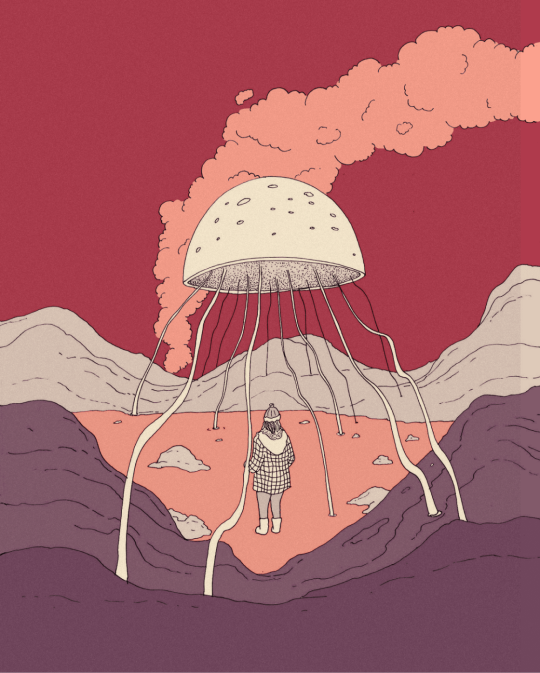
Q. Could you kindly elaborate on why you choose visual styling, conceptual thinking and experimentation as the roots of your work?
Saloni: l usually start with experimenting, which is sort of an open field to play around and have fun. At this stage, I’m not bothered by the end result. Once you have one or two good concepts, you can start to refine and build something intuitively. Lastly, you decide which sort of visual styling would best suit the concept. Normally, I tend to play around with colours and typography to decide a mood. I don’t believe in a fixed process; I feel you can iterate and keep an open mind.

Q. Which have been the noteworthy clients and projects you’ve worked for and could you highlight some valuable experiences you’ve had in particular?
Saloni: Some of the projects/clients which are special two me are:
Saptan Stories – a 7-week long collaborative arts event hosted by Aardman Animations (UK) in collaboration with British India. I was really happy to be hand-picked among 7 artists from the UK and India. Every artist had to interpret a story written by the masses. It also felt personal in some sense as I had just gone through a break-up and each line coming in felt like what I had experienced, though with a mix of fantasy in it.
Tailor & Circus – I had the opportunity to create a set of design prints for their underwear collection and also to design a sustainable packaging hamper. They’ve been very inclusive about their audience. They are bold in their approach and sustainable, so I feel proud to be associated with their work. I thus got to see my illustration in a different medium, which is always exciting.
Album Cover for Amogh Symphony ‘IV’ – The artwork for their album turned out to have a very different take in terms of the look and feel, unlike conventional metal band covers. The art was conceptualised with the title track ‘Birds’, which emphasised feminine freedom and connection with mother Earth.
l usually start with experimenting… Once you have one or two good concepts, you can start to refine and build something intuitively. Lastly, you decide which sort of visual styling would best suit the concept.

Q. In terms of technicalities like colour scheme, lighting, proportion and the likes how do you describe your style and approach?
Saloni: I usually tend to work towards a minimal style. I spend more time sketching and inking before I start to digitise. In most of my work, I try to keep the use of colors to a minimum of two or three while colouring digitally. In my opinion, two to three colours bring good balance and harmony. I add depth by adding some tints and tones while sometimes playing around with unconventional proportions to bring surprise.

Q. If you could determine one thing about the field of art today, what would it be and why?
Saloni: Art can be more immersive with upcoming technologies. People can experiment and combine different mediums to create enriching experiences.
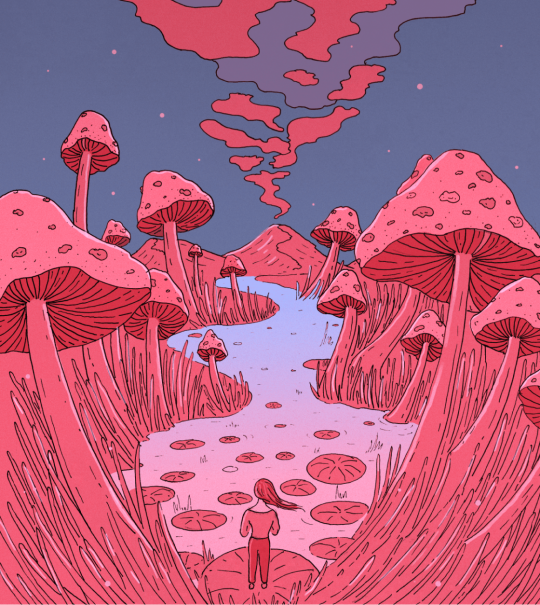
Q. What particular efforts or ways do you take to understand and achieve what is expected by a client?
Saloni: Understand clients thoroughly, making sure they are involved in each stage of ideation. At the same time, give yourself time to refine your ideas. Ideally, you don’t want to show them the entire process of brainstorming since it may expose them to half-cooked ideas and confuse them. Once you have a few directions for them to choose from, you can funnel your design sooner.
Sometimes it will also depend on what kind of client you get – there might be clients who are particular about something, while some give you more liberty. As an artist, though, you can take that lead in direction while still keeping the brief in mind.

Q. How do you choose subjects and the manner of conceptualising them in your illustrations?
Saloni Sinha: My subjects keep changing from time to time. Earlier, I was heavily inspired by the metal culture and dark fantasy, so I naturally made a lot of punk/spooky drawings. Nowadays, with my growing interest in space and nature, I draw a lot of inspiration from the two and amalgamate them with everyday life and fantasy.
Q. What kind of projects do you dream to do and what draws you to them?
Saloni Sinha: I’d love to work on a project related to sustainability and nature conservation that can make an actual impact on our planet. And, for fun, I’d love to make album covers for some of my favorite bands as I love music.
2 notes
·
View notes
Note
I know for questions, you're probably talking about Far From Home, but what about William, the fish guy? What was he like in the early days of character development? How has he changed since you first thought of him? And I guess, same question for the FFH folks. Thanks in advance.
I was honestly so excited to receive this question because I LOVE my boy William! Plus it’s fun to talk about character origin stories.
Buckle up. This is gonna be a long answer.
Up until 2014 my art largely consisted of fanart or fan characters, so I had never produced content that was truly original. During spring of that year, I stumbled upon and quickly become enamored with some original characters on deviantart, many of which were ‘monsters’ (vampires, mermaids, werewolves, etc.). Seeing these characters inspired me to create my own story with characters that catered to my own interests.
William is the first original character I ever created, so he has a special place in my heart. This is my very fist sketch of him! (Sorry for the low quality.)
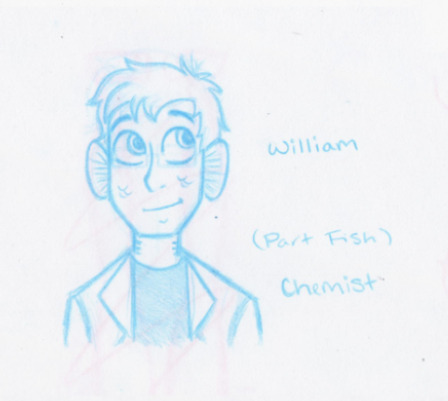
My initial idea for his story was disorganized and had a lot of missing pieces. In the early days of character development, William was nothing more than a character I liked for his design and personality. I had very little experience with character creation, so I put a lot of myself into him. He was shy and timid and anxious at times, but he also had low self-esteem and didn’t feel like he fit in anywhere. And for good reason — his backstory was one of confusion and grief. Originally, he was an orphan that had been kidnapped by scientists and genetically modified to resemble a fish, all while retaining his previous characteristics and a humanoid shape. The scientists raised him and were training him for some unknown task, of which I never decided before changing the direction of the story entirely.
William and his story turned six during March of this year, and both have changed A LOT since then! He’s no longer a chemist, nor does he have any experience in the sciences. I also gave him some glasses and a nice argyle sweater (which now serves as his classic look, haha), and I’ve decided he’s of Asian descent for reasons explained in a few paragraphs. Not only have I refined his story to be more practical and understandable, but I’ve also given William a purpose, something to pursue. He’s still anxious and feels like he doesn’t belong, but he doesn’t stay that way forever.
I always liked stories about monsters, in the sense that something not-quite-human longs for a place among normal people. Society views these ‘monsters’ as unnatural or potentially dangerous, and yet the monster displays more humanity than the humans themselves. I really want to lean into that idea as I tell William’s story. He may not be your typical monster, but he certainly feels like one. Different, unnatural, out of place. Yet he has a kind heart and a childlike fascination with the world. The road is difficult, but with a bit of help he eventually finds his niche.
Here’s my most recent sketch for comparison, and a lovely depiction of William by my pal HareSoup!
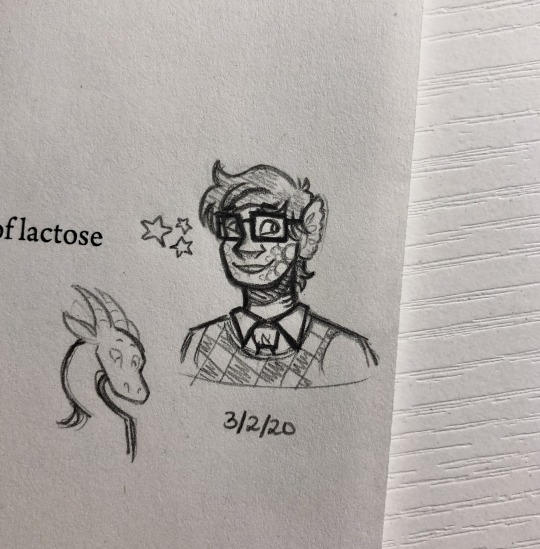
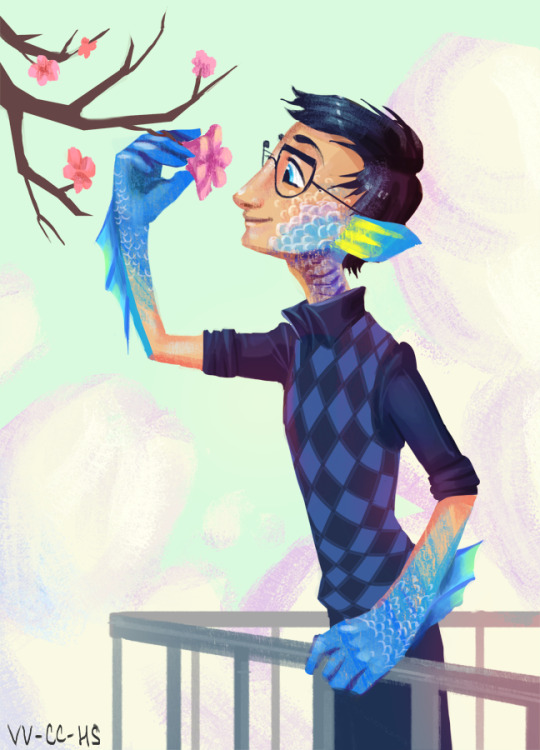
Besides the few changes mentioned above, Will hasn’t changed much design-wise. He has fins in place of ears, gills on his neck, scales scattered across his face/trunk/limbs, and a bit of webbing between his fingers/toes. He can breathe underwater and on land, but his scales and gills have to receive moisture every 1-2 hours or he’ll develop health issues/fall ill.
I don’t remember when I decided I wanted to write a full-length book telling Will’s story, but it’s still a goal of mine! To give you a brief synopsis of the current story, now titled “Fish Out of Water”, it takes place some years after the signing of the Conventional Forces in Europe treaty, which officially brought the Arms Race to an end. During the Arms Race, nuclear weapons were tested without concern for radiation and the effects it had on nearby civilians. In one particular scenario, Asian civilians were evacuated from a small town-turned nuclear test site, but they were not properly protected. The offspring of these civilians developed unnatural deformities/features, such as extra limbs or feathers, as a result of exposure to unhealthy levels of radiation. Worried that this development would mortify the public, the government hid the children in a science facility stationed in a secluded part of the ocean, and they remained within its walls for years. After 28 years, William escapes the facility with the help of his guilt-ridden caretaker and is found unconscious on the shore of a coastal city by marine biologist Martha Collins. The story follows Will as he attempts to shake his government pursuers, but it’s really a story about friendship, self-worth, and discovering what it truly means to be human.
Though unfinished, William’s story is very special to me, and I’m looking forward to sharing it with the world someday :>
As for the Far From Home folks, they came from simple beginnings. It all started with a sketch — this one to be exact!
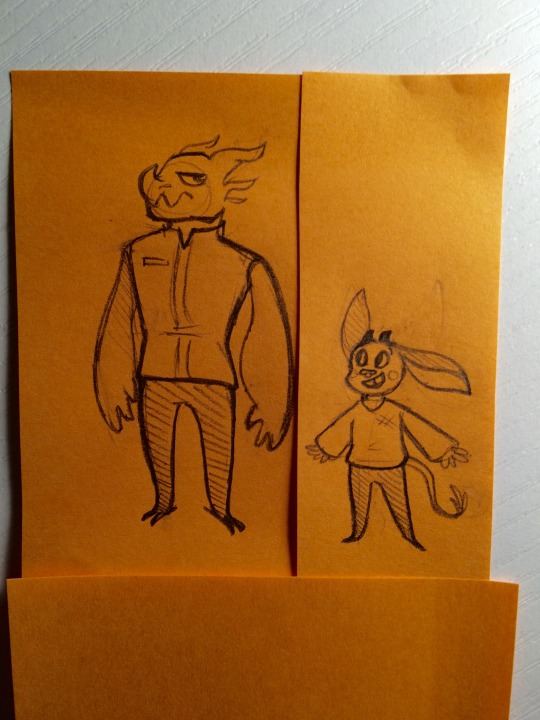
Back in the spring of 2017, I was stressed and tired and frustrated with school, so I thought it’d be fun to create some new characters. Specifically, comfort characters that fit my favorite tropes. I took a lot of inspiration from the movies “Ernest & Celestine” and “You Are Umasou” when it came to personalities and character dynamics. I loved the idea of a tough, grumpy man who is completely unqualified to be a father stumbling upon and eventually adopting a small, bright-eyed child. There’s just so much you can do with that concept!
I specifically remember sitting in the library at school and just…drawing. I had no initial designs in mind besides something big and sharp, and something small and soft. Two opposites that would become a makeshift family.
I liked the designs enough to digitalize them, reworking aspects of their designs in the process. This was the first ‘accurate’ drawing of Baz and Toko. (I don’t like it too much anymore, but it’s a good color reference!)
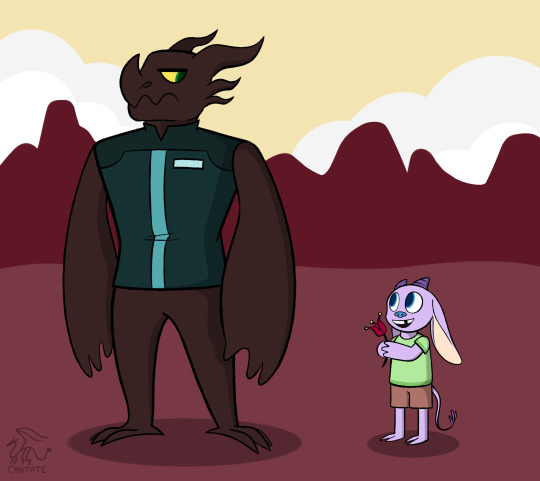
I never like leaving a character without a story, so I eventually came up with a couple ideas that adequately described their relationship. In fact, my first idea presented Toko as some sort of child princess and Baz as her assigned bodyguard! That one obviously didn’t stick, but it did allow me to gain a better understanding of what I wanted.
Over time, I did a bit of world building and expanded upon the FFH universe, which opened and closed doors for potential storylines. I realized I wanted to add more characters too, leading to the creation of Gerdie and some other important figures. Gerdie looked quite a bit different than he does now — in fact, he was originally supposed to be an android! I played around with that idea for a while before eventually discarding it.
Here’s my most recent size chart featuring all three main characters!
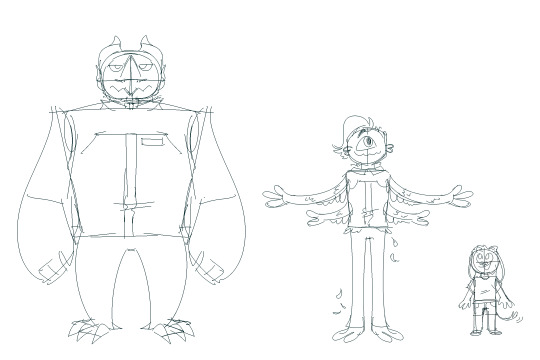
I honestly never expected Far From Home to expand beyond a simple idea, and yet here I am, thinking I can turn the story into a trilogy someday. There’s still a lot of work to do if I want to reach that goal, but I genuinely enjoy these characters and their dynamic is really fun! They’ve grown very dear to me over the past three years. So I think that’s reason enough to try, anyway.
To give a bit of background on the story itself, it’s set in a fictional version of outer space where humans don’t exist. Intelligent, technologically-advanced aliens from neighboring planets/galaxies have established contact with one another, leading to the gradual formation of an intergalactic government and melting pot mega-society. Due to the unforeseen complexity of this endeavor, strict rules were put in place to regulate the selling/purchasing of certain goods and services, transportation between galaxies, and other related activities. This system is not without complications.
Baz and Gerdie work as intergalactic merchants, but that’s just a cover for their job as smugglers. Together, they travel to different galaxies and exchange goods for the designated currency, as well as deliver illegal substances to specific planets. Baz is the captain and pilots the ship while Gerdie is an engineer and works as the mechanic. They’ve known each other for quite some time when the story first begins. Baz has quite the interesting history, much of which ties into important aspects of the story.
Toko is a young alien who gets separated from her family and wakes up in the storage unit of Baz’s ship, with no memory of how she got there. Baz finds her and suspects she’s a thief, but she quickly explains her predicament and asks that he help reunite her with her family. Baz is reluctant at first and denies her request, only to discover there’s more to her story than he originally thought. Unintentionally dragging Baz into a frightening adventure full of old friends and all-too-familiar foes, Toko eventually inspires a change of heart in the smuggler. The story explores themes like forgiveness, what it really means to be good/bad, and the idea that family isn’t defined by blood.
I know that was a lot, but I hope it was at least somewhat interesting! Thanks for asking about my characters and sticking with me through this <3
6 notes
·
View notes
Text
Evaluation of units 1 – 4.
Unit 1 -Introduction to materials, processes and technical skills in art and design:
Through the project ‘All System’s Go’ we were introduced to various materials and processes some of these processes and materials were digital and some were practical processes, at the beginning of the course we were introduced into Adobe Photoshop and Adobe Illustrator with these two materials we learnt various processes and tools most of these processes and tools were simplistic but would later be used in more complex situations to create better outcomes, these tools were crucial to learn for the development of our work throughout the project. Adobe photoshop and illustrator weren’t the materials we used to create outcomes we also touched up on more practical and hands on processes such as Mono printing and carbon paper printing these practical processes were also important for the development of our skills as it allowed us to have a wider knowledge on different processes and skills. Other skills we learnt were important for experimentation, experimentation was important as it allowed us to use our knowledge of the processes we had been learning and allowed us to create more detailed and professional work. Including Adobe Photoshop, Illustrator, Mono printing and Carbon paper copying we also looked at Collaging in Photoshop to create architectural Risographs along with hand bases studio collaging where we created collages based on our research from Hannah Hock and Terry Gilliam, research was an important process and skill along with referencing and evidence our work as it allowed us to learn from our experimentation and our unsuccessful outcomes, we continued to learn processes in Photoshop and illustrator along with our studio work building up to create one of our final outcomes, the final outcome we were working on would showcase and evidence most of our best work this outcome was a Zine booklet and to create it we had a set criteria of only using a simple double colour pallet along with monochrome this was created in Adobe InDesign which was another tool we had to use.
We created a large variety of outcomes using different processes and techniques some of these outcomes hadn’t met my personal criteria or the standard of work I would have liked but I used them as learning points for later outcomes and evidenced them, one of the processes I hadn’t originally like or that I found hadn’t met my personal standards was the Mono printing and Carbon copying processes and outcomes although I thought they weren’t my best work I later used them to create the Vintage postcards which I thought had been one of my outstanding pieces through the project these had later been put onto my zine which is one of the main final outcomes. another outcome we created that I both liked and thought was a good example of the skills I learnt throughout the workshops and lessons was the 80’s Memphis pattern outcomes I personally think these were my best pieces and would like to continue working within the 80s theme, another theme I enjoyed was grunge we briefly touched up on this when we were researching David Carson and creating collages linking to his outcomes.
Within the first project, ‘All System’s Go’ we looked at and experimented with various processes one of the main processes we used at the beginning of the project that we continued through was Typography I used this in various pieces of my work, we started to learn this technique through creating an A – Z in Adobe Illustrator and developing it further within Adobe Photoshop, I took this process onboard and put it within various pieces of my work such as my zine where I used it for my front page and used it to highlight various sections within an outcome along with using it within my Vinyl Album cover outcomes, the typography techniques I learnt I adapted to various outcomes. another process we looked at that I decided to use within my own personal work was the polygonal workshop where we looked at polygonal shapes and experimented with animals, I enjoyed this process so much that I decided to experiment on it within my own time looking at the size differences of the polygonal animals. Nine out of ten of the techniques and processes I learnt I had decided to use within other outcomes to help develop them and create more complex outcomes. Throughout the project and the act of learning the processes there was various processes that I enjoyed doing some of these processes included the polygonal animal outcome and process, Architectural Collages and Risographs, Memphis patterns and the mock-ups, Album covers along with my stickers and final zine.
Unit 2-Introduction to contextual research in art and design:
Throughout the unit and the project, ‘All System’s Go’ we had been given a lot of contextual research that helped shape and develop our work some of this contextual research was through self-study and independent research on the styles themes and processes, this research and context produced through self-study and provided through Demos helped shape and impact my work heavily as without this contextual research I wouldn’t understand nor would I know how to do certain processes to produce my artwork and final outcomes, the contextual research was one of the most important things for my project.
Research within the project and for each new workshop was critical for the improvement and development of my work and my ideas as without this research I wouldn’t have new processes or ideas some of the most critical research I had looked at was done by self-study and my own research along with Demos and artist names provided for example of this would be the research done for the Memphis patterns and Mock-ups we were tasked to look at various 80s inspired Memphis patterns through this research I had developed many ideas and techniques I wanted to try this research helped me then do further contextual research for processes which I then used to make my 80s Memphis patterns unique and interesting and to a level I thought was perfect. Research for each outcome and each experiment was important as without it I wouldn’t have the in-depth understanding about the work I enjoyed looking at a variety of artist for research one artist I found particularly interesting was Hattie Stewart here work is fun and playful using bright colours that pop out creating really Pop art inspired pieces although I didn’t take a lot of here design choices onto my own work I enjoy and respect her work another artist that I ended up liking was Lynette Jackson this was due to her unique style within Architecture and digital collage using bold colours and empty space to make here work pop.
Although research was vital and important for understanding processes and the techniques, we used I hadn’t always taken references or the style of the artist due to this my work would sometimes differ from the artist research or in contrast would be quite similar.
Unit 3-Introduction to drawing skills:
With Sam we learnt an array of drawing techniques and tips, we learnt these processes starting of simple and working to more complex things an example of this would be how we started with simple kawaii faces, kawaii meaning cute in Japanese then building it up working on full faces learning proportion and how to section the face for drawing we also learnt about body proportion and different body shapes learning the basics, after we had learnt these processes we were tasked with practicing them and using what we learnt to create sketches and pieces.
For the next project as we will be developing our drawing skills, I would like to learn more on stylised anatomy and how to take the skills from learning that and making it more stylised, in conjunction with this I would also like to learn more with shading and detailing within character design.
Unit 4-Introduction to communication skills in art and design:
In and throughout our project we had to communicate our processes and our work and the steps we took to create our final outcomes to do this we used various resources at our disposal one of the things we used to evidence and communicate our work was Tumblr on Tumblr we created blog posts, posting our final outcomes along with screenshots of the processes including written step by steps along with contextual research to go along with this looking at artists, processes and techniques for nearly every outcome there was a post referencing an artists or a piece of research including the process along with a comparison of my work. To show what we did we used various things one being Tumblr but we used other methods such as one to one discussion with teachers and peers on improving and developing our work. Although advice was good to listen to it didn’t always have to be taken as in the end its our own work and its tailored to us and our style, two other very important things we did to communicate our work and processes is to write this 1000 word evaluation along with a portfolio with an array of work selection our best pieces for it.
Thought the project I blogged and referenced my work on Tumblr although I managed to do this with most of the outcomes and experiments and research I feel like I could have done more to update and keep on top of these blogs providing further detail and refined blogs this has been a learning curve for me as blogging and referencing my work is a new concept although I didn’t complete my blogs to the best standard I believe I did a really good job referencing my work and making sure there was something showing what I had done even if it was a WIP or a DRAFT.
I feel like I created well developed outcomes final outcomes I personally feel like I exhausted my opportunities to perfect my work and put it at a standard I like and is nearly professional.
Although I haven’t fully pieced together my portfolio, I feel like I have exceptional work that would fir my portfolio, I also believe my work portrays my skill and shows what I have learnt and how I can adapt and develop my process around what I’m working with. I am proud of my work and I can’t wait to develop it and learn more techniques that will help me grow as a student and an artist.
8 notes
·
View notes
Text
Soundrs: DJ CYBERDAD
My name is John Verchot, I’ve released music under several names: J-chot as well as DJ CYBERDAD. Locally, I’m usually just billed as DJ Verchot. I feel like the first thing I should tell you about myself is that I have severe ADHD, which seems to be the single most consistent force guiding my art and existence. I often get distracted and always get ahead of myself when I try to explain things. DJ CYBERDAD started out as a funny pseudonym to release more profane songs that I didn’t want my son to hear, but changed into an outlet for my smoother dance jams as well as more introspective music.
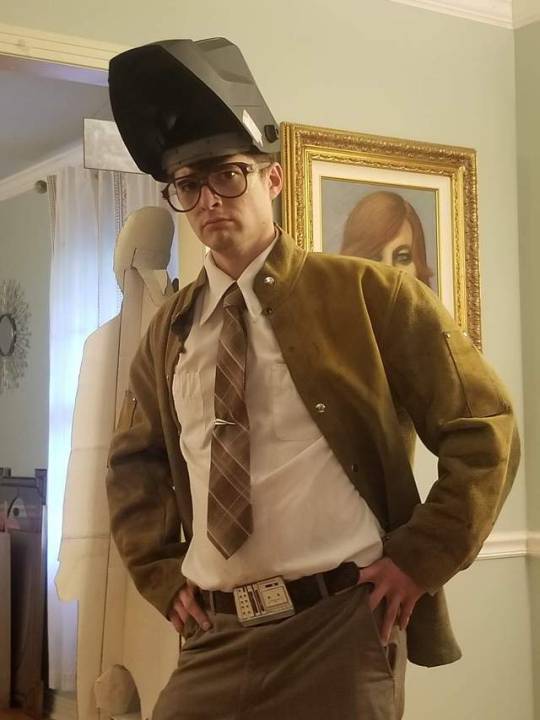
What are your inspiration sources?
It varies from project to project. Often times with tracks, the inspiration to work on them comes in two or three different phases. Inspiration to create sounds is one thing, as inspiration to finish and structure tracks, create moods/themes, or even package them into a finished project, all feel like different driving forces/processes that need to happen in order for me to get anything done. However, whichever one of those forces I am able to utilize when I sit down at my laptop often seems to be beyond my control.
Most times I’ll hear a sound, loop or phrase, I’ll start to wonder what I can do with it, or how I can change and manipulate it. It might be the timbre of an old instructional video’s narrator, or an odd metallic sound I’ve managed to coax out of some equipment. Occasionally I’ll think of a concept, either of overall sound or thematic content and before I know it, I’ve got half a track planned out in my head. Many times I’ll hear other tracks or songs, and want to use just one part/concept/sound or re-do the whole track differently. With “Emotional in Destin”, I was trying to convey moods or feelings I felt during an unexpected trip to Florida in the middle of a crushing depression. It sounds bizarre, but I've never channeled personal experiences into my music before.
Overall what inspires me to create different sounds is the novelty of technology and bits and other people’s music.
What makes me want to sit down and make music is personal or professional success.
What inspires me to finish tracks and projects is the distant white noise of overwhelming anxiety and dread setting in as the ennui of the imminent collapse of western society fades giving way to the dark, almost imperceivable thrumming of the void drawing nearer, and is definitely getting louder. Your “time” is almost up John. Did you even do anything, or are you too skiddish and feeble of heart and head to make any clear decisions, impulsively flitting from one animal urge to another bad habit, clogging the chemical receptors of your brain for simple stupid pleasure. It’s night now and your eyes and fingers grow weary…
What was the question again?
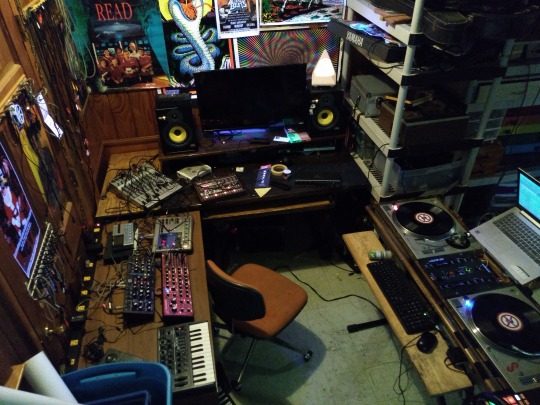
Tell us something about your workflow.
Most times, it starts with just noodling around. Sometimes, it’s with synths and sequencers, either recording sounds or looping notes and tweaking/loading patches (virtual or real synths), sometimes I’m browsing potential sample material, but what happens next is the same regardless of how I’m making sounds or what I’m doing:
…I think hear something.
…And I STOP noodling. Basically, I either hear something I like, or I hit a riff or whatever and it’s like a tiny, tiny light bulb that blinks barely. Occasionally it’s like a hundred watt, and other ideas quickly fall into place. Most times, it’s a process of trial and error, but I’m making sure to document or isolate the little pieces that click and then attempt to refine or improve on those ideas. Ideas can quickly diverge, multiple sets with different names get saved, and I often jump around and get lost. I use color coding on clips and pieces in Ableton to help me sort those ideas. Some ideas form by running one sequence I’ve had already through a whole different synth/patch.
Very rarely, I’ll get a concrete idea while I’m driving, maybe I’ll make some notes on my phone (text to speech notes, voice recording).
When I get a spark that makes me imagine a full concept (“Charles Nelson Riley”, or that “My P**sy tastes like Pepsi Cola” remix for example), the track is formed VERY quickly (four to eight hours working time) and I finish the mix, structure, everything. This is rare, but these tracks are almost always my better material.
The next step is always the same: Let the track “cool-off”. Leave it alone. Do something else for a few days, or weeks… or in some cases, years… Then I’ll fuck around with it even more, or move on to:
STRUCTURE & MIXING:
I look for/experiment with arrangements that compliment my DJ style, or allow someone to do a rough edit if they want, (breakdowns at the end), or I’ll load a track that I like to DJ that’s similar enough and I will STRAIGHT UP copy the song structure in terms of intro, (drums or keys?) repeating bits, breakdowns, outros… Most times I fuck with it until it sounds okay, which is kinda bad because I end up drastically overscrutinizing it.
When it comes to mixing, something that I should do more often but don’t is load a reference track (someone else’s track) and try to get my mix to sound like theirs… This technique REALLY helps stop “nasty surprises” when you listen to it on a big system, or in the car.
Most of the time, I’ve been tweaking the mix the entire time I’ve been working on the project.
TL;DR
The “Emotional in Destin” EP is almost entirely soft synths, but lately my flow is:
1. dick around on hardware
2. “oh that sounds good, let me make another sound to go with it” (see step 1)
3. record a few pieces to an Ableton project.
4. “I don't know what to do now.” …maybe mixing or structure…
…almost ALL THE TIME, however I jump around and do everything very non-linearly. Hardware helps me not spend so much time tweaking patches or EQ-ing a snare drum for an hour. Texture is SUPER important to me, so I’ll often get hung up on EQ and compression before I even start on structure or mixing.
How would creative rituals benefit your workflow?
The hardest part for me is ALWAYS ALWAYS ALWAYS getting started, or shifting gears from other activities (resting after work, reading tumblr, goofing off…) and going to sit down at my desk and start music stuff. I’m certain it’s an executive dysfunction thing. The less I think about doing it before I do it, the better.
Animal sacrifice SIGNIFICANTLY speeds things up. Try not to get blood on the gear/laptop, and make sure never to clean, but regularly sharpen the ceremonial dagger (VERY important).

How do you get in the zone?
I don’t really try…
As soon as I start to approach a task as “a thing” I get nervous and anxious. If I go “okay, I’ve got this task to complete…” my subconscious hijacks my higher functions to make me look at memes or tumblr for three hours instead of do what I “should” or “want”… The problem with me in the past has been how do I get OUT of the zone?
How do you start a track?
Oh jeez, I really jumped the shark with that question earlier, didn’t I? A technique I’ll sometimes employ is load up an old track, keep the drum sounds/patches but delete all the data, and make an entirely different genre of track… or one that's very similar… That’s kind of a fun exercise if nothing else. Also it often winds up getting tweaked and adjusted to hell and back.
Do you have a special template?
Nope. I make TONS of drum, EQ, and effects presets though. And they all have terrible names like “gooddrums”, “$GOODrums” and such.
Even though I’ve started with carbon copies, they ALWAYS end up sounding completely different by the time I’m finished with the track, because I can’t leave em well enough alone.
What do you put on the master channel?
Sometimes EQ, but always a phat ass compressor (limiting). I’ve been thinking about investing in a nice non-free one lately, but for some reason I am not comfortable with purchasing software plugins… I also have learned recently, that I’ve been using compression on the individual tracks way too much… which makes final-mixing a pain in the ass.
How do you arrange and finish a track?
DAMN IT. I really did go too hard with the first couple questions. The “finishing” of a track for me (arrangement, mixing) is usually done much later than the rest of the process. I try not to force stuff, but lately I’m realizing more and more that I need to not do this as much.
I can’t stress enough how using a reference track for structure or mixing can very often break up stagnation on a project.
How do you deal with unfinished projects?
Several ways. The first step is to judge an old file and see if it's worth finishing. If there is ANYTHING of creative/sonic merit, I put it in a folder with the other “sketches and ideas” (project graveyard). Otherwise, I have been trying to delete the “junk” projects… this can make it easier to focus. Another thing I often do is to make presets/patches/Ableton instruments from the parts I like, then drop it in a folder called “meh”. Or I drop them into several categorical folders, i.e.: “uncircumcised electro bangers”, “abrasive techno”.
How do you store and organize your projects?
Aw jeez. Oh gosh-oh darn. (See above answer.)
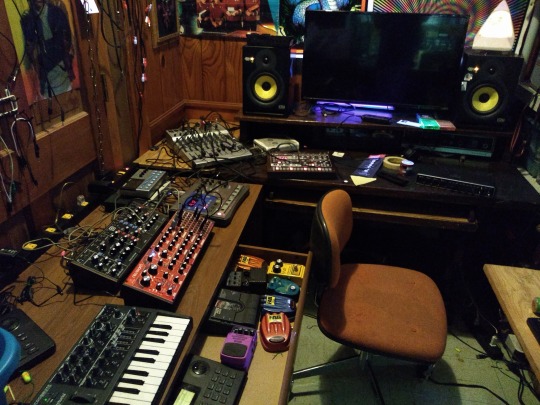
How do you take care of studio ergonomics?
Trial and error, trial and error, trial and error. This year alone my studio has been restructured and moved about my downstairs room at least five times. I’ve finally settled on something that feels very useful and productive. I am also this way with my work station at my job. CHANGE IT UNTIL IT WORKS GREAT. This can also help with creative stagnation, or can trigger it, so be careful. I keep my “electronics laboratory” close at hand so that more of that tinkering can find it’s way into my music… no such luck, YET.
I’ve currently decorated my space with all the crap I’ve saved up over the years, that for some reason, I’ve looked at this and thought: “This makes me happy” …SUUURE, my studio now looks like a fourteen year old decorated it, but I gotta say, I feel pretty phenomenal. Soon I’m gonna try to put this “stars and space” wall paper on my ceiling… I’ll update with a photo when that’s done.
Also I would like to say:
Minimalist spaces and studios are bullshit, y’all look like sick baby birds in empty shoe-boxes.
I mean, NOBODY LIVES THAT WAY, right? Maybe some boring rich people do, but damn… I mean, I try to clean and stay organized… and it helps, but I also try not to get to hung up on it.
Tell us something about your daily routine, how is your day structured, how do you make room for creativity?
**LOUD SUCKING SOUND THROUGH TEETH** I don't… at least, not very well at all… but I’m working on that.
I am not the person you should ask this question, because THIS RIGHT HERE is the BANE of my existence…
Share a quick producing tip.
MAN, I’ve already dropped like… seven, but okay, here goes:
BY ANY MEANS NECESSARY, FINISH THE TRACK. For me, this means ghetto-rigging, DIY, using the same goddamn audio interface from 2002 for f****ng fifteen YEARS… (recently fixed) don’t get hung up on “proper” ways, or ways that are outside your current means. Also, get a set of decent monitors… or use several pairs of headphones/speakers to double check mixes.
Recently, I’ve had less time, but a little bit of money, which is the opposite of how I’ve ALWAYS operated… it’s been difficult to unlearn “time consuming but cheap”. Also difficult not to impulse buy synths.
Making music with just a mouse and keyboard may be the least sexy thing ever… it works tho… cheap MIDI controllers CAN work faster however.

Share a link to an interesting website (doesn’t have to be music related).
My son just showed me this ➜ https://dddance.party/ and I have to say, this is an outstanding achievement of mankind.
List ten sounds you are hearing right this moment : )
Traffic outside my window, gentle hum of laptop cooling fan, dog snoring, fingers typing, birds chirping… that’s it.
John has a lo-fi house EP out on UltraBold Records as DJ CYBERDAD. It’s called ‘Emotional in Destin’. Stream it ➜ here, audio cassettes are available ➜ here.
Thanks John! If you want to get featured next, send a message here on tumblr or email [email protected].
#soundrs#soundrooms#interview#inspiration#workflow#workspace#creativity#electronic music#House Music#lofi#producers#producer#audio production#music producers#music producer#Music Production#audio producer#audio producers#dj cyberdad#ultrabold#ultrabold records
40 notes
·
View notes
Text
Interviews
DVC Major: Bridget Hassely
1. What would you have liked to know about the DVC program before coming here?
I would have liked to have known how important process books are. For some reason, it wasn't made clear to me we had to keep our process books for portfolio review. I deconstructed my first two books to reuse the folder. After I found out that we needed them, I had to piece back together what I saved and reprint my files.
2. What would you like to know about the professional design world?
I would like to know just how many pathways there are to take with this degree. There are so many options and hearing people talk about their experience with the pathway they chose is very interesting to me.
3. What is the hardest concept in design to understand?
The hardest concept in design for me is using the grid to the best of its ability. I tend to stick with my trusty columnar grid, but I would like to venture out more and get used to using all the different types that might be better for specific projects.
4. Which Adobe program would you like to learn more about? Why?
I want to learn more about Photoshop. We learned the basics in Art 118, but Photoshop has so many more tools that would probably be beneficial to me that I want to learn and understand how to use them.
5. What is the most helpful design tool in your opinion (such as a type ruler)?
The most helpful design tool, in my opinion, is a sketchbook. Documenting your inspiration, thought process, ideations, and reflections is critical. IT gets it out of your head and onto a physical space where you can come back to and expand off of.
6. What keyboard shortcuts do you always forget?
A keyboard shortcut I somehow always forget is the arrow key (selection tool), which is V. Also, why are the shortcuts different between the Adobe programs?!?!
7. What stores would you have liked to know about Freshman year?
I would have liked to have known about the architecture store and the arts and crafts studio.
8. What are some fun design elements you look for in a handbook?
Some fun design elements I look for in a handbook are interactive bits, jokes, imagery, useful tips, and space to answer questions.
9. What driving factor would make you carry around a DVC handbook?
A driving factor that would make me carry around a DVC handbook would be its usefulness. Having information that I could frequently look back to or something that I have to fill out over time would make it more useful for me.
10. What was the hardest part about taking introduction to DVC courses?
The hardest part about taking introduction to DVC courses for me was adjusting to the time commitment that design is. Design is not mechanical and can take many attempts, variations, and refinements. Procrastination is hard to avoid, but giving yourself enough time to work through the design process will make your work so much better.
DVC Graduate: Kayleigh Kvool
1. What are important aspects to include in a graphic designer resume? Is it true that design employers pay more attention to the look of the resume than the content?
All of your skills. All of your experiences, work experience, and other related experiences done through school. I have an exhibit section where I put my DVC2 and DVC3 showcase. If you look at a job description, make sure you have the skills on the resume that they want. Yes, but not totally. It should be very clean. Lots of simplification. You want it to be simple. A lot of resumes go through scanners, and you want it to be legible.
2. Do you have trouble looking for a graphic design job?
I wouldn’t say it is hard. It’s competitive. Put yourself out there and take chances.
3. Do you think the UWM DVC program prepared you well?
Yes. The improvements I have seen in the program has only made it more preparatory for designers. I love the Dream Lab. Professional Practices with Amy was the most preparatory thing ever. I took that class my last semester before graduating.
4. What was your favorite DVC class? Why?
DVC 3 was my favorite. I really thought it was valuable to work in a group. The manifesto was fun. It was the most work, but the work you make in that class you are the most proud of.
5. Which teacher helped you the most in gaining design knowledge?
Robert Grame. He gave me a lot of one-on-one feedback. He kept my ideas focused and doable. I do think it is important to have a mix of people.
6. What places would you recommend for internships?
Union Marketing was basically it. I also got six credits doing it.
7. Do you do freelance work often?
I am open to it. I am still trying to figure out what is an appropriate amount to charge. Everyone tells me to not undersell myself. If I would do freelance for a company, I would charge $40 an hour. The minimum is $20 an hour. If I was still a student, I would charge $15 or $20. Now that I am graduated, I would charge $40 or $45.
8. What is your favorite part about being a graphic designer?
I think that my favorite part is that I get to be creative and make my impact by representing communities. People have a negative outlook on advertising. It is nice to try and make a positive contribution.
9. If you could choose what job you could have right now, what would it be?
It would definitely be with Z2 Marketing as a Design Director. It only requires two years of experience. I am very qualified for it. An art direction position right out of college would be very stellar.
Design Professional or Entrepreneur: Mary Adamczak
1. What is an average day in the office like?
It’s different every day! Each day I have my list of projects to tackle. My time is dictated by the client’s deadline. The hottest project gets my attention first. I also will get interrupted to review other projects that are in the works to discuss with our creative director and other designers. I do have to say my colleague brings his dog to work most mornings which is fun. The dog runs around the office to greet everyone. She also will bounce balloons, like she’s some star volleyball player. The rest of the day she doesn’t make a peep in her kennel, until she leaves for the day. Then we get greeted one more time before going home.
2. Which method do you use most when working with your clients, email or in person conversations?
I would say it’s mostly email. I typically do not present a lot of creative here, but I do attend meetings and will be involved in the discussions of the projects with clients.
3. How long does the average project take?
Hmm, that’s a hard one. I’ve spent hours on jobs and under an hour on jobs. One rough logo exploration could take a couple days - but exploring variations is what takes more time. A 12-page brochure could take 3 -4 days or so for the design only (with copy supplied) A small website (design only), not programming could take 3-4 days (with copy supplied) And this is without interruptions!
4. How would you describe your role as a graphic designer?
I’m a creative / a designer, sometimes a creative director, a project coordinator, print coordinator and sometimes a project manager. So, I wear many hats.
5. Which clients do you work with the most?
We mostly have corporate and tourism clients at the moment. Some projects are ongoing but, some are on a project by project basis. We also have done some specialty hard cover book projects for specialty events and sports teams which is challenging but rewarding in the end!
6. What is the biggest project you ever had?
A corporation that made an acquisition and they needed to send out a bunch of collateral out in 13 different languages. This included a Corporate Folder which housed a letter from the CEO, A Code to Ethics brochure and a corporate brochure. This was a lot of coordination! We had to work with the printer to have it all shipped out to the different countries. Also, working on specialty hard cover books. These are big projects that can take up to a year to concept, design, get approved and printed.
7. What made you want to go into graphic design?
I’m a creative person and wanted to do get paid for something I love to do.
8. Where did you study? How did your education prepare you for your current career?
I received my Bachelor’s Degree from MIAD (Milwaukee Institute of Art + Design). I had 2 really good graphic design teachers who saw my work ethic and worked with me to show me what really good, high level design should look like.
9. What is the biggest lesson you have learned as a graphic designer?
I’m not sure there’s a lesson I’ve learned. I do know that design is subjective but, it takes a good eye and an openness to exploration to see good design. Never assume your design is good, just because your hands are creating it. Always step back and see how you can make it better and more successful. And be open to constructive criticism from your peers - it will make you a better designer.
10. Where do you get your inspiration from?
Other good design. I really enjoy looking at Commarts.com (Communication Arts Magazine).
11. How many sketchbooks do you have, completed and currently in use?
I go through a lot of notebooks, not just for sketching, but for making my daily lists, jotting down thoughts, ideas and sketching out home related things that I want to figure out. I’ve sketched out how I want our outdoor Christmas lights to look, our kitchen configuration, and some of our garden beds. You can use creativity in so many ways!
12. What is your favorite Adobe program? Why?
Hmm. I think I like InDesign the most because I use it the majority of the time. But, Illustrator is a close second, as I love designing logos in this program.
13. What was something unexpected you learned when starting out?
How quickly projects are needed - tight deadlines.
14. What types of projects do you enjoy working on the most?
The ones that have extra time! And the ones that have more creative opportunities. Projects that are more open-ended, not defined. That gives me more creative freedom.
15. What is your favorite part about being a graphic designer?
Being creative and being able to design. I love taking a blank page and designing something that is creative, unique and relevant.
1 note
·
View note
Text
October 19th-October 25th, 2019 Creator Babble Archive
The archive for the Creator Babble chat that occurred from October 19th, 2019 to October 25th, 2019. The chat focused on the following question:
Describe your design process for new characters. How do you go about it?
Holmeaa - working on WAYFINDERS
Ohooh it is my time! First I draw a bunch of quick drawings of body and face We are a small team, so then we had discussions, we knew how they looked in general, sallly had to be small with curls etc. Then when the body was chosen it was time to draw outfits. Since we are doing a whole world we had to find out about what kind of clothing generally people would wear, what accessories, what does nobels and rich wear, contra poor, what is religious garments. Then the faces had to be chosen and drawn again. Then when all elements was in place, it was time for colors. For Lani, I did like 30 different versions of colors, ans combination before we found the right one. For side characters there has been only a few sketches, and since we knew the whole class system with clothing, it was easier to pick and match compared to place in society. Then thinking about the role the person have in society. Next is designing scientist, and that's going to be fun!
Line up if the finished designs of the main(edited)
Face exploration
[IMAGE]
=
More final clothing design
[IMAGE]
Color exploration
[IMAGE]
spacerocketbunny
Oh damn I love all this! I never thought of actually mapping out all the different classes religious/ non religious formal/ casual etc. That's so smart! And these designs are so cute ahhhh
Holmeaa - working on WAYFINDERS
aaw thanks! It was very important for us that it was clear to see! Since the man Andrée is a nobel, and Sallly was part of a crime gang, and Lani is a tempelgirl, and we do have a lot of different social groups
The Q - working on WAYFINDERS
And their homeland is very northern/Viking inspired. I'm very excited to show the other country in the story, which has a much more Mediterranean flavor!
Also yes @Holmeaa - working on WAYFINDERS is super impressive!
Holmeaa - working on WAYFINDERS
Aaaaaaaw you are too sweet!
AntiBunny
Process? Not so much a process as an idea forms in my subconscious and then like Athena rises fully formed in armor from my head. After that they will go through a few revisions. Usually they get simplified a bit, I try to make them a bit more iconic, and easier to draw repeatedly of course.
In AntiBunny http://antibunny.net/ this resulted in some of the earlier character designs being a tad inconsistent, for instance a character in a T-Shirt interacting with a character in a long winter coat.
Since then I've been trying to come up with more consistent seasonal outfit designs. With Book 2 I think I've gotten a lot more consistent with the outfits all making it very clear that it's summer.
So short version is that it starts out with them forming organically from loose ideas, then getting refined and redesigned over time. Not exactly the most scientific approach I know.
LadyLazuli (Phantomarine)
For new major characters in Phantomarine (http://www.phantomarine.com/) I usually try to design a character and draw them at least 5 times before I have them show up in the comic. Their initial design usually pops into my head pretty quickly, but I do a bunch of test drawings to A) see what looks best and B) isolate things that might be difficult to replicate, and simplify them as much as I can. For new minor characters, my process is way more haphazard - and I’ll admit I fall back on a lot of similar face and body shapes when designing incidental crowd characters or random one-line characters.
But the area I’ve had the most fun jumping into - and didn’t expect to even try out - was costume design. I imagined my characters staying in their main outfits for the entire story, but was encouraged to design wardrobes for each, just as a fun exercise at first. And now, I see outfit-swaps as ways to get out of drawing ruts - and it’s more fun for the readers, too! Makes total sense that characters would switch clothes over a longer story, so when I started doing it, it was not only a “OF COURSE!” moment, but a huge relief in terms of being allowed to try new designs. I’m really looking forward to drawing my characters in all sorts of different ways now.(edited)
The Q - working on WAYFINDERS
THem color schemes though!
MJ Massey
I need to get better about this. I usually slap dash throw characters together, especially background characters, but based on their character traits, I have an idea of how I want them to look.
For my main characters, I start drawing them a couple times, mostly just doodles and then like a concept art or two to really get the hang of them, but I find that drawing them in the comic is what gets them under my fingers the best
Emily and Chester were the ones I designed first, as the two mains I wanted to make sure they would play off each other well. With Emily, the key thing was to make sure she wasn't too cute or attractive--she's supposed to be kind of plain looking and a little drab
Chester, in contrast, is soft and playful looking while Emily is more angular and sharp
Cronaj
For Whispers of the Past, my characters have gone through several redesigns over the years, as I spent time planning the comic, getting better at drawing, and discovering the deeper personalities of my characters. As it is my first comic, I wasn't very organized in my initial process. Since my art style is not very cartoony, I don't use the same stylistic cues to help the readers tell the characters apart, and instead, I rely on a lot of subtle features to tell them apart, such as Agatha's thick eyebrows and full lips:
Or Izrekiel's round under-eye, or his round face:
Some of these reference sheets are more complete than others, and some are older or newer depending on how much help I needed when adjusting each character's designs to my evolving style.
Desnik
I usually start with writing them before I totally know what they look like. Sometimes they wind up with props that I need to work into the design as the story gets rewritten.
Deo101 (Millennium)
For me I generally have a solid idea in my mind before I start drawing. I draw that idea, refine it a bit, and then I draw them about 10-100 more times, depending how much they'll show up. For background characters i pretty much design them right then and there, but for major and minor named characters, i need to get comfortable with them and really test how they react to things. I also will paint my main characters, because I find that forcing myself to fully realize what the character would look like realistically really helps me be more informed when I'm simplifying them later! I tend to focus pretty strongly on color, and tend to monochrome designs. There is also some research involved, where i make moodboards once i get the initial design down so I can refine things! A lot, i know.
#ctparchive#comics#webcomics#indie comics#comic chat#comic discussion#creator interview#comic creator interview#creator babble#comic tea party#ctp
2 notes
·
View notes
Note
Hey! Your underground temple is absolutely stunning!!! I was wondering if you have any process pics of it? I would love to see your workflow :)
Hello and sorry for the late reply !
I did this design during my summer internship last year, andi was under the supervision of @vnzzz who taught me the steps to follow inorder to understand background design. I’ll try to explain those steps and my personalprocess through this thread.
1. Early stages : Thumbnailing andsketching
Here are a chunk of the sketches i did to begin with :
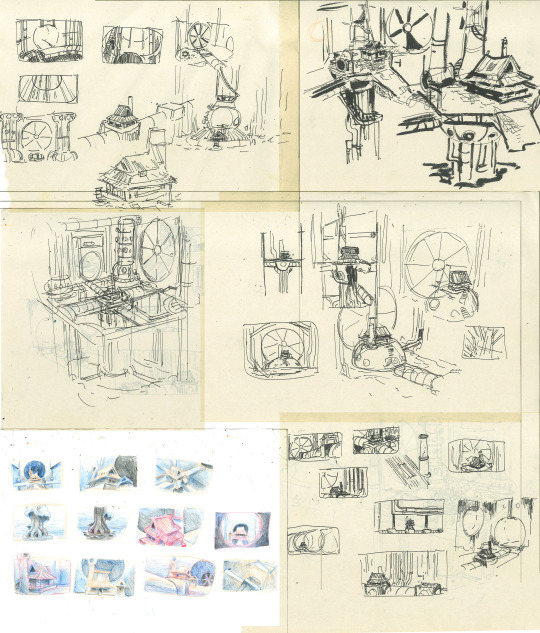


My first sketches (not shown here) were way too focused on details, and mysupervisor brought me back to the essentials : getting a strongsilouhette, making a clear statement. The key word being : concept. Myidea was an underground forgotten temple, trapped within a huge structure, akinto huge sewers mixed with industrial elements. The goal was then to design theplace like i would with a character : trying to find a good shape andsilouhette, a clear one, that quickly translate your idea to the viewer. Atthis point there is a lot of brainstorming to do, and refining your concept byasking yourself a lot of questions :
-How did this place came to life ?–Who lives there ? –What kind of time period is it ?
2.3D model
Once i had made enough research to figureout the global design of the scene, i made a 3d model in google sketchup. Ithelped me to figure out the global proportions of the place and have a betterunderstanding of its volume. This is a free and very simple software that irecommend a lot ! The other great advantage of 3d in this case is that youcan place your camera anywhere you’d like and generate a simple linework out ofit. This method is used in production work because it allows layout andbackground artists to start with a good volume and perspective basis. Fromthere, they’ll use a design reference and complete the linework.
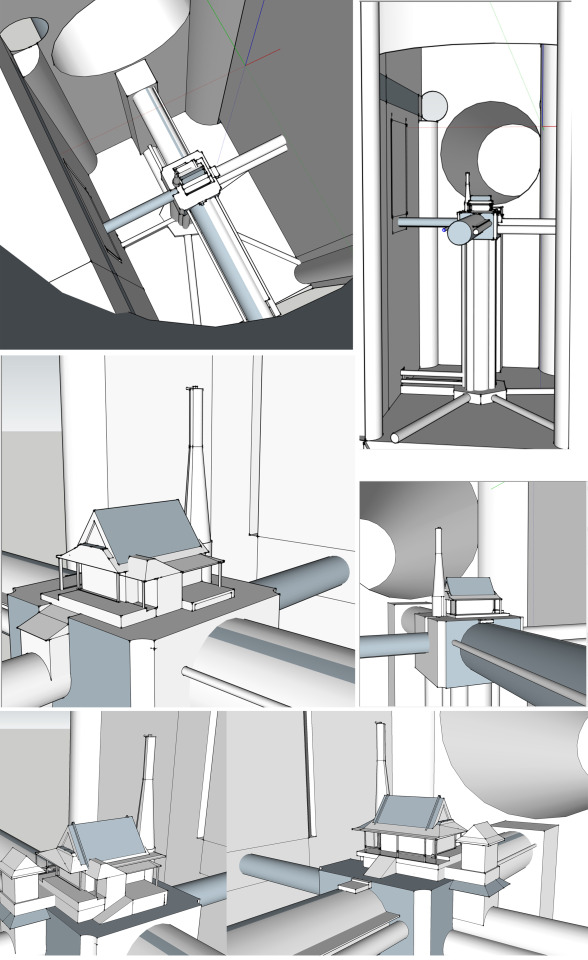
3.Roughing things out

After choosing an interesting view of thetemple, i started to add the main structural elements. It was a process ofgoing back and forth with my supervisor who provided a lot of advices andcorrections that i applied the best i could to the design. Going through manyiterations, the temple started to take form. One of the important task was toadd details without loosing the sense of structure and silhouette. It isimportant to establish good scale relationships between the elements in orderto keep it coherent.
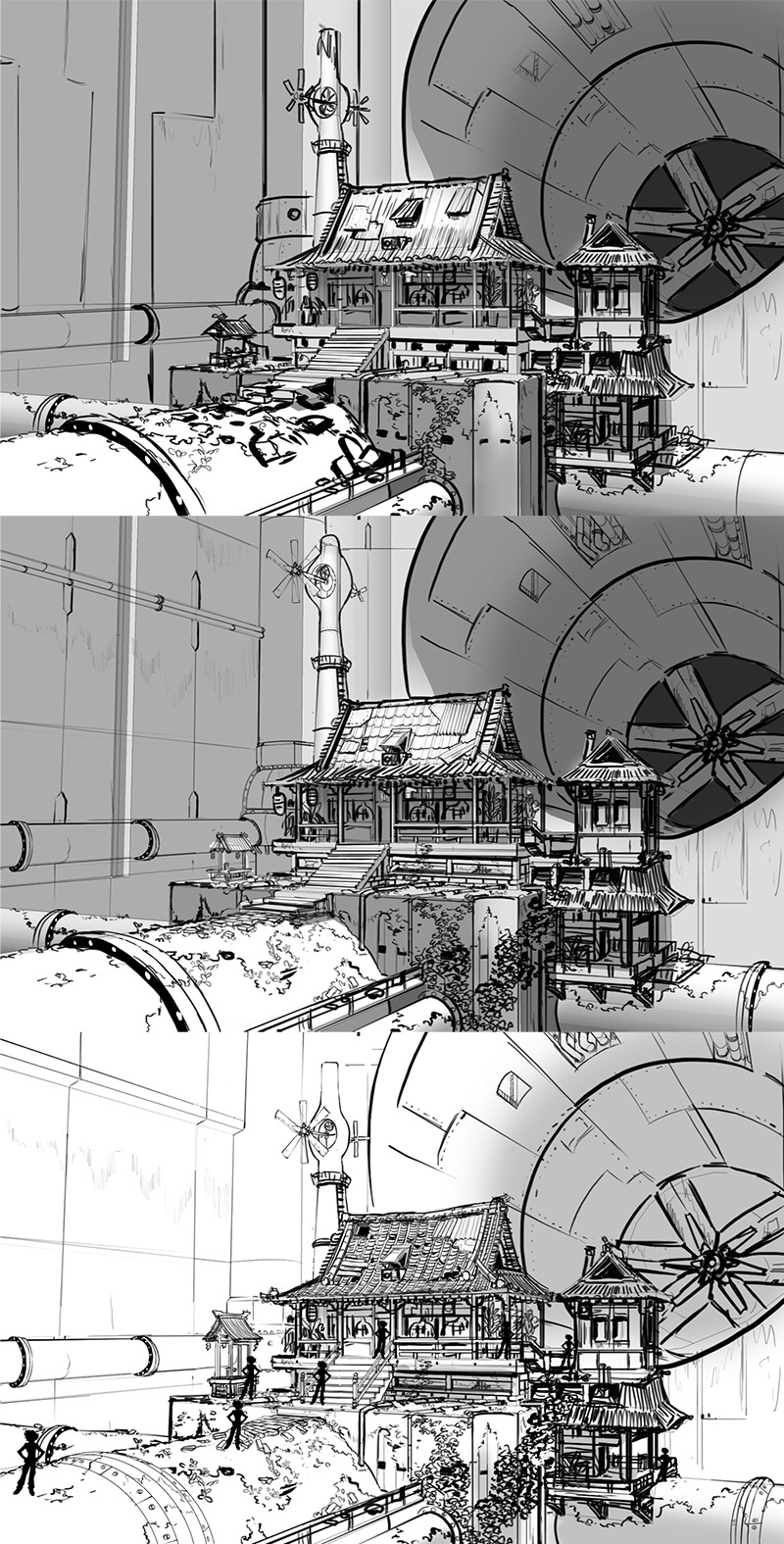
This brings me to the next point :
4.REFERENCES
This is probably one of the most criticalpoint of drawing in my opinion. Ourimagination is fairly grounded in reality. It is really hard for us to imaginesomething completely from scratch, especially in the fields of drawing andcreative work. If you want to draw something which is believable, be it acharacter or background, you’ll need to understand it well. The references thencome into play. Internet gives the artists of today a tremendous amount ofinformations and photographies about a huge range of topics, that artists fromthe past couldn’t even dream of, and it would be a waste not to take advantageof it !
In my opinion, understanding is key, andmore important than copying. While using references, a good thing is to analysewhat you are seeing, deconstruct the information in order to re-use it at wishwhen you need it.
Here are just some examples of references ipicked up for this design :


The sewers of Tokyo : This was a hugediscovery for me ! I had no idea that this kind of structure existed and iwas amazed by its sheer gigantism ! And it also was a perfect fit to whatkind of ambiance i was looking for!
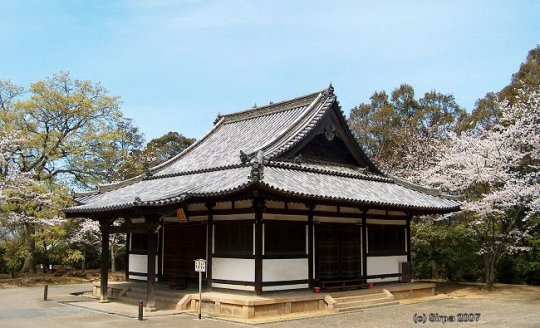
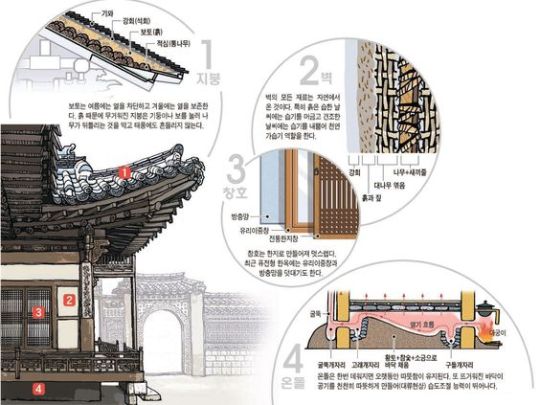


A LOT of temple, shrines and eastern asia architecturereferences ! I needed to know and understand what i was seeing, how thoseroofs would assemble, what shape would the pillars be, what kind of materialsand details would compose this kind of architecture and so on…
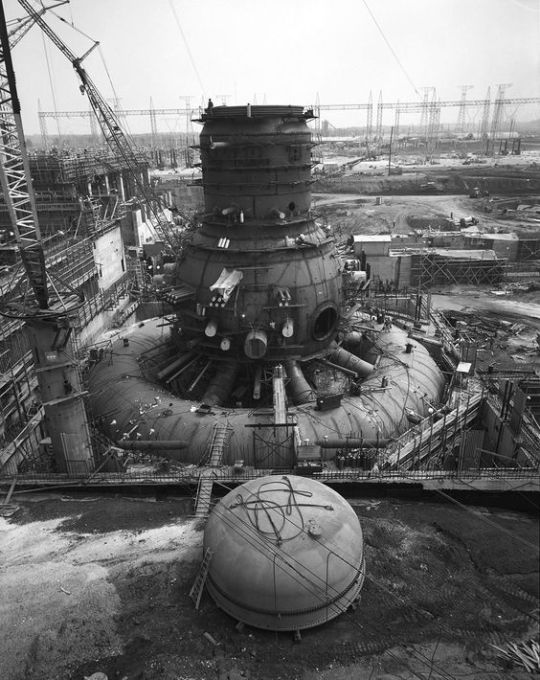
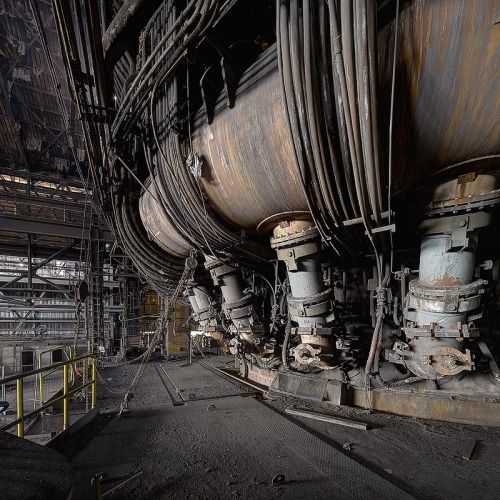

Some industrial and mecanical references aswell for the pipes and ruins around !
5.Cleaning and coloring
While using references, i went on tocleaning. When designing a background, i don’t think you need to have a perfectlinework as long as everything reads well and clearly. At this stage it ismostly refining everything, adding details. A good thing is to have differentline thickness for the foreground and background, details and global shapes. Itbuilds hierarchy and make different planes differenciate better from eachother.

I added simple colors areas in order tomake the different elements of the design stand out. It doesn’t relate to thereal colors, they are merely informative.

Once i finished everything, i decided to bringit to life with color, and then compositing and 3d, but this would deserve a different thread !



6.Last words and ressources :
I hope you enjoyed this thread and that it’llbe of any help !
Go check the blogs of my supervisors andcolleagues during my internship, they do RAD backgrounds :
Vnzzz
Yann Legall
Thomas Romain and his perspective tipswich are a must-have ! They are very clear and useful !
Concerning resources, i would recommend (ifyou haven’t already) getting a pinterest account with loads of boards.
Also check https://www.textures.com it is basically aimed for 3d texturing, but there is a lot of variety in shapes and forms whichcan be useful when looking for references.
There also is THIS reddit called the « safefor work porn network » Despite its strange name, this reddit has thousands and thousandspictures about many different topics. You can spend hours gathering referencesthere.
As a conclusion, i would say go anddraw, draw a lot, and draw some more, keep practicing, analysing, referencing,designing and having fun !

Have a nice day !

#background#tutorial#ask#ressource#thread#design#background design#visual development#aimation#mric#art#artists on tumblr#development#temple#underground
766 notes
·
View notes